#indian henry hunting ground
Explore tagged Tumblr posts
Text

Setting up camp in Indian Henry Meadows on Mount Rainier.
Washington
1977
#vintage camping#campfire light#washington#mt rainier#indian henry hunting ground#history#camping#hiking#exploring#1970s
232 notes
·
View notes
Text
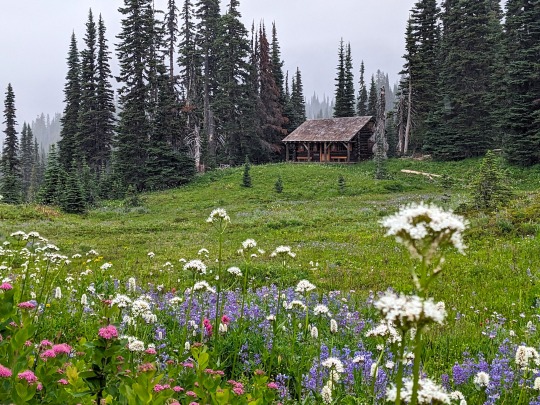
Subalpine meadows around the park are shining with numerous blooming wildflowers. Some common wildflowers, seen in this photo from Indian Henry’s Hunting Ground, are lupine, Sitka valerian, rosy spirea and more. However you don’t have to go far to view wildflowers. Paradise Valley Road, for example, has excellent displays along the roadway. Where are you finding wildflowers?
Remember, please stay on trail! There are plenty of opportunities for the perfect mountain + wildflower photo from the trails! No need to step off trail and crush other flowers in your quest for the perfect shot.
For updates on what’s blooming where visit https://go.nps.gov/RainierWildflower
Unfamiliar with Mount Rainier’s wildflower species? Check out the wildflower guide at https://go.nps.gov/RainierWildflowerGuide
NPS Photo of wildflowers at Indian Henry’s Hunting Ground, 7/24/23. ~kl
#Rainier Wildflowers#wilflowers#mount rainier national park#Indian Henry's Hunting Ground#patrol cabin
55 notes
·
View notes
Text

Indian Henry's Hunting Ground, 2023 Mixed Media in Sketchbook
Not being able to hike this year is really sad. I've been trying to paint in my sketchbook places and things I would like to see next year.
My ACL surgery is Wednesday, and I both excited and terrified.
#my art#landscape painting#mt. rainier#mt rainier national park#pacific northwest#watercolor#washington state#sketchbook
38 notes
·
View notes
Text
#2543 - Diaphorapteryx hawkinsi - Hawkins's Rail
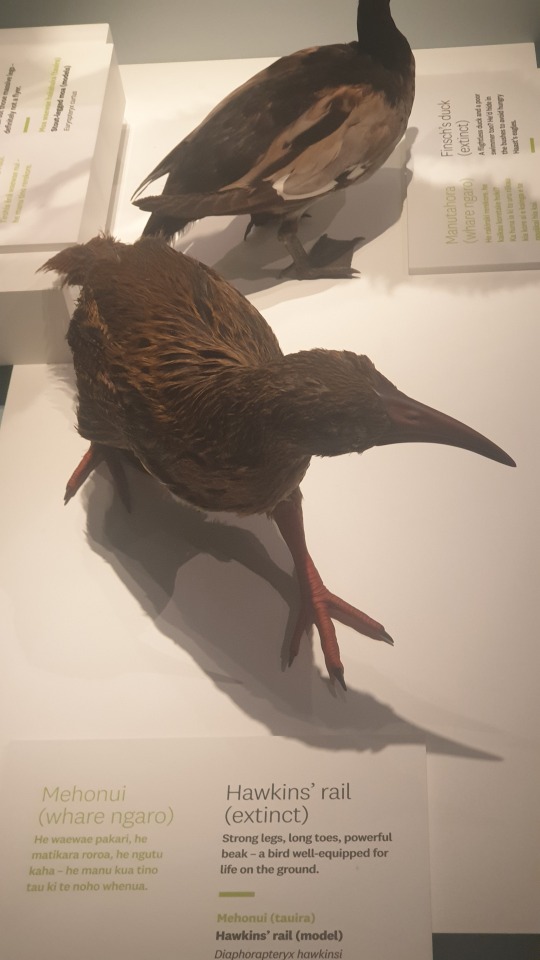
AKA Giant Chatham Island Rail or in Moriori as mehonui.
Yet another flightless bird hunted to extinction, although this one lived only on the Chatham Islands hundreds of kilometers east of Aotearoa. Again, a reconstruction at Te Papa, since they were gone by the time any ornithologists arrived to take an interest.
Possibly not that long before though - an 1895 letter from Sigvard Dannefaerd describes the appearance, behaviour, and Moriori hunting method concerning the species:
The Large Rail that Forbes Clased as Aphenapteryx the Moriori Name for same is “Mehonui” (nui mens Large) I hunted ap the oldest Moriori Chief on the Island and ther tradition of the Bird is, it ware Larger than a Goase and had a verry loud Cry like Tue-ck it always walked with the Head down pecking in decaed wood on the Ground, the would often catch them by walking stret ap to them from the front of them, but they could not cam over them from the side, and the yused to Sleep together in Colonies and the Morioris yused to find out ware a Colony had ther Sleeping plase, then sneek quietly ap and make a rush and Kill the hole Colony. The described them as of a Dull Brick Red Colour
Original described by Scottish ornithologist Henry Ogg Forbes in 1892, who thought it was evidence there was once a land bridge between the Chathams and the island of Mauritius in the Indian Ocean. I leave picturing the shape of the neccesary continent as an exercise for the reader.
Despite Forbes' theories, not closely related to the extinct red rail of Mauritius. Genetic evidence insteads points to the invisible rail (Habroptila wallacii), from Halmahera in the Maluku Islands, Indonesia, with their last shared common ancestor existing around 10 million years ago. Still a pretty substantial geographic distance. The two rails were then in turn found to be most closely related to the genus Gallirallus.
Te Papa, Wellington, New Zealand
#Diaphorapteryx#Rallidae#extinct species#new zealand bird#chatham islands#te papa#wellington#flightless rail#rail
0 notes
Photo

Indian Henry Wilderness, Washington - by Derek Culver
#washington#indian henry#mount hood#hunting ground#flowers#mountains#people#night photography#stars#trees#forest#fog#nature#scenery#landscape
193 notes
·
View notes
Text
Adventuring Mt. Rainier: Hiker's Heaven
Adventuring Mt. Rainier: Hiker’s Heaven

This is the same face of Rainier that residents of Seattle see every clear day. Much better up close!
The first time I saw Mount Rainier up close I was completely blown away. I was 19 and had been in the Pacific NW for less than a year. The Cascade Mountains seemed like the Himalayas to my East Coast eyes. And Rainier is the biggest and baddest of the entire range. When I got that first good…
View On WordPress
#adventure#backpacking#bear#Cascade Mountains#Indian Henry&039;s Hunting Ground#landscape photography#MJF Images#Mount Rainier National Park#nature#wildflowers#wildlife
2 notes
·
View notes
Text

Erwin Buske
"This image was taken in early August at Indian Henry's Hunting Ground, Mount Rainier National Park. This cabin is in as beautiful setting as I could ever imagine and is like walking into a dream. Indian Henry, known as Soo-Too-Lick, early on (1883) guided several familiar names to Mt. Rainier including the Hunting Grounds, these familiar names include James Longmire Philemon Beecher Van Trump and John Muir. Indian Henry was a Cowlitz Indian, beloved by many people."
45 notes
·
View notes
Photo
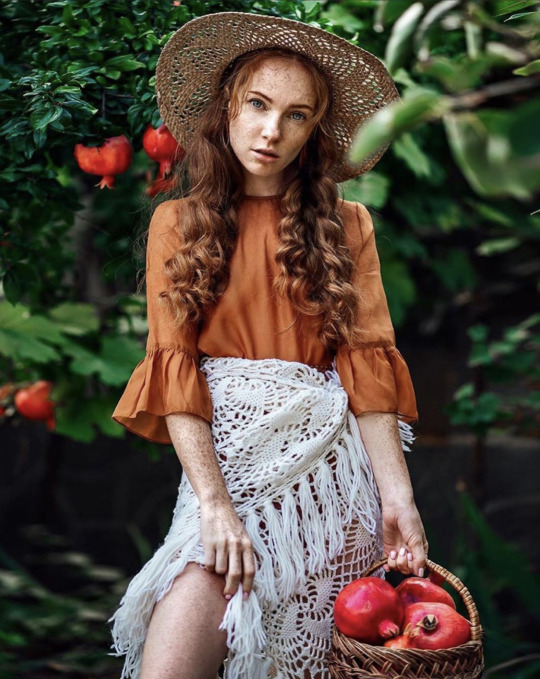
“The older lady harrumphed. "I warned you, daughter. This scoundrel Hades is no good. You could've married the god of doctors or the god of lawyers, but noooo. You had to eat the pomegranate." "Mother-" "And get stuck in the Underworld!" "Mother, please-" "And here it is August, and do you come home like you're supposed to? Do you ever think about your poor lonely mother?" "DEMETER!" Hades shouted. "That is enough. You are a guest in my house." "Oh, a house is it?" she said. "You call this dump a house? Make my daughter live in this dark, damp-" "I told you," Hades said, grinding his teeth, "there's a war in the world above. You and Persephone are better off here with me." "Excuse me," I broke in. "But if you're going to kill me, could you just get on with it?”
- Rick Riordan, The Last Olympian
In the Greek myth of Persephone's abduction by Hades, lord of the underworld, the pomegranate represents life, regeneration, and marriage. One day while out gathering flowers, Persephone noticed a narcissus of exquisite beauty. As she bent down to pick it, the earth opened and Hades seized her and dragged her down to his kingdom.
Persephone missed her mother and the bright world above ground. But her new status as Queen of the underworld and her love for Hades gave her reason to stay with him. She believed that she had important work to do deep under the ground.
Persephone knew that if she ate or drank anything in the underworld, she would have to stay there forever. Even though Hades begged her too have just a sip, or one bite of food, she didn’t.
Demeter, the corn goddess, had finally learned where Persephone was. She insisted that she be returned to her or she would prevent the earth from bearing fruit unless she saw her daughter again. Hades sadly hitched his horses to his chariot and prepared to take Persephone back under Zeus’s urgings. But before they left, he offered Persephone one last thing to eat – a ripe, blood red pomegranate. Looking him in the eye, Persephone took six seeds and ate them.
They went back above ground, up through a crack in the earth. Persephone threw herself into her mothers arms, joyous to be reunited. The earth again grew rich with flowers and the sun shone once more.
But, because Persephone had eaten six pomegranate seeds, it was decided that for six months of each year, she must return to the underworld with Hades, on Mabon, and winter would come to the world. In spring she would once again return to her mother, allowing the earth to bloom.
By eating a few pomegranate seeds, Persephone tied herself to Hades - the pomegranate being a symbol of the indissolubility of marriage.
Growing up in India and Pakistan, I was taught by cultured friends that Persian soothsayers held a different vision of the tart fruit's purpose in life. Above all the unfortunate connotations of death and winter, the pomegranate was, and always would be, the fruit of hope for the Persians, Afghans, and Indians. The flower of fertility, of new things and old seasons to be cradled.
In a way it chimes in the way the pomegranagte has been portrayed as a symbol of resurrection and life everlasting in Christian art. Here the pomegranate is often found in devotional statues and paintings of the Virgin and Child. In medieval representations the pomegranate tree, a fertility symbol, is associated with the end of a unicorn hunt. The captured unicorn appears to be bleeding from wounds inflicted on him by the hunters. The “wounds” are actually pomegranate seeds dripping their blood red juices on his milk white body. Wild and uncontrollable by nature, unicorns can be tamed only by virgins. Once tamed, the unicorn was held in an enclosed garden and chained to a pomegranate tree, symbolising the impending incarnation of Christ.
Even within English history the pomegranate has featured heavily as a symbol. The pomegranate was part of Catherine of Aragon's coat of arms and was accepted into English heraldry when she married King Henry VIII in 1509. The Royal College of Physicians of London had adopted it in their coat of arms by the middle of the sixteenth century.
The heraldic meanings of the pomegranate then hark back to the meanings of the pomegranate in the myth of Persephone and the historical incarnation of Christ - the persistence of life, fertility, and regeneration.
#poemgranate#rick riordan#quote#literature#demeter#perspehone#hades#classical#greek#persian#indian#christian art#article#aesthetics#symbology#fruit#culture#religion#society#fertility#regeneration
29 notes
·
View notes
Text
Captain’s Daughter
Part 1

On one of the expeditions, you’re forced to tag alongside your father. He doesn’t want you to come along, but with nowhere else to go and no willpower to leave you on your own, he brings you. Will it be trouble with you constantly butting heads with the most stubborn man of the bunch?
———————————————————————
Wednesday
“The proper thing to do would be to finish him off quick.” Fitzgerald grunted as he slumped against the bark of the tall tree behind him. He had a wooden pipe clamped between his lips, smoke escaping his mouth as he spoke. His tone was careless, firm. He was always full of bright ideas. His boots crushed the snow beneath him when he shuffled, the audible crunch drawing your attention to him. You were stood a few feet away, trying your best to tune him out. He’d always had such a huge problem with Glass. You weren’t exactly sure why, but all the anger and hatred and venomous words he spewed at the man left you gawking. He always started a scene. And he always eventually had to say something about Glass’ son, he was part Indian, always referred to as a half-blood.
Anderson was watching the scene take place below. Glass was laid in the dirt, at the bottom of the steep hill. His skin was covered in the dark grains, cuts and wounds sprinkled with dirt in the blood that gushed from his injuries. “He’ll be dead in less than an hour.” Anderson assured Fitzgerald. He was the only one of the group that tolerated Fitzgerald and his loud mouth.
You rolled your eyes toward the men before watching intently as your father, Henry, the leader of the group, tended to the wounds Glass had endured. Glass’s son, Hawk, was hunched over, teary eyes spilling over with the salty droplets as he worried about whether or not his dad was going to make it.
Your attention was once again pulled to John Fitzgerald. The man lifted his hand and momentarily adjusted the bandana that was wrapped around his head. The long strands of brown hair tickled his chin, blending in with the heavy amount of facial hair that covered his upper lip and chin. “Yep, we’re all gonna be if he doesn’t quit wailing like that.” Fitzgerald pushes off of the tree and made movement to step around the gents that had gathered. He was going to the edge of the cliff to relieve himself. His bladder had been ready to burst for fifteen minutes and he figured it was the perfect time to piss.
You snatched his arm when he made movement to move past you. The cold air tickled your cheeks, making your skin all the more icier. The beanie you wore did it’s best to protect your forehead, but your skin was growing agitated and itchy and your ears were numb despite the cloths attempt to shield them from the wind. You couldn’t imagine how painful they’d be if you didn’t have the hat — much like the surrounding men. Staring up at the man when he came to a halt in front of you, you narrowed your eyes. John Fitzgerald butted heads with everyone in this group, including you. He’d seen you only a handful of times without the big bulky coat and the beanie on. He’d, at first, found you to be extremely attractive. He’d pondered flirting with you. But you were just as outspoken as your father and just as stubborn as himself. John let out a low growl when you took your time to speak. He knew you were going to say something to him about what he’d been babbling about.
“You’re pathetic.” You informed him. Your breaths escaped in visible clouds. “He was just attacked by a fucking bear and you’re standing here saying it’s best to finish him off.” You pulled your lips in, rubbing the cold, pink flesh before you released his arm. “Grow up, Fitz.” Your arm hit his when you moved past. Heading for the edge of the cliff so you could descend it and assist your father in tending to the wounds, you barely lifted your foot before John spoke up.
“Not very ladylike to eavesdrop, is it?” John adjusted the rifle in his hands. Hooking the strap around his strong shoulders, he lifted his brows. Wrinkles formed along the length of his forehead as he ogled you.
“It’s not considered eavesdropping when you’re talking as loud as you were. You wanted Glass to hear you.” You sighed heavily. This man was a waste of your time. Pursing your lips, you began to climb down the hill. The wind whistled loudly, drowning out any response the man may have had.
Glass’s wounds weren’t going to be fixable. Bridger had helped disinfect the gashes. Henry had done all he could to soothe the man laid in the dirt, doing his best to assure him, along wirh his son, that they were going to do all they could to save him. Men scavenged for wood, trying to find something sturdy they could tie his body to. They couldn’t leave him lying here, but they couldn’t very well sit in one position for too long either. The entire group was under constant attack, hunted by the Indians that resided in the woods, constantly trailing them, ready to kill them and steal their pelts. You did your best to avoid using a weapon. You hadn’t killed anybody yet and you didn’t intend to. When the group was under sudden attack, you were always protected by someone. It partially annoyed you. You knew it was because you were the youngest, and because of your gender, and because of your father’s leadership over the group. But just once, you wanted it to be because someone cared about you.
Before long, Glass was attached to a wooden board and hoisted up by the men. They did rotations, each one having to carry a part of the board for a certain amount of time until their hands were numb and their backs started to ache. You tried your best to have your own turn, an attempt to participate in some of the heavy lifting. You grabbed an available corner when it was vacant, but the second your fingers curled around the wood, Fitzgerald stepped up behind you, his broad chest grazing your back. “Leave the heavy lifting to the men, girl.” His hand swatted at yours. You sent him a glare, ready to elbow him and insist you could handle it, but your father summoned you.
“Y/n.” He pointed to the pelts in the center. “Grab some. Let them carry Glass.” His words were dismissive. He didn’t want to make a big deal out of anything and start an argument, he just wanted you to help carry the smaller necessities.
You heaved a noisy, defeated sigh. It was a sound that made Fitzgerald smirk. Poor little princess couldn’t have her way. He took his corner, swiftly lifting his end of the board. He carried it with ease and he didn’t do it to make sure Glass was safe, he did it so they could get a move on. He didn’t want to be stuck out in the open when darkness came.
—
Thursday
Everyone was tired. Their limbs ached and their muscles complained. Each man was stood around the board, the heavy wood was set on the ground, Glass no better than he was a few days ago. Fitzgerald was leant against a rock, his heavy breaths filling the silence that settled between the group. You were stood in the corner with your arms folded and your feet shuffling, listening as the man converse over the fact that the rest of the journey was steep, uphill, and they’d never be able to carry Glass all the way. Your father did his best as Captain to ensure Glass wasn’t mistreated. Some men, Fitzgerald, suggested putting the man out of his misery. That wouldn’t work though. Henry would never be able to pull the trigger. Others suggested the group divide, whoever wanted to carry Glass the longer route home, until his recovery or inevitable death, would be rewarded. Hawk, of course, volunteered to go with his dad. The remaining men were quiet, all waiting impatiently for someone else to speak up.
“I will too.” You said nonchalantly. Every man looked in your direction, amusement sprinkled in their gazes. You? Their eyes said.
Your father straightened. “No.” He said simply before looking back toward the gents, his lifted brows speaking what his lips didnt. ‘Nobody else?’
“It wasn’t a question.” You told your father bluntly before pushing yourself off of the tree and moving toward the block of wood. “You won’t let me help hunt. You won’t let me help spot for ree.” Your brows creased. “And you won’t let me watch the man, let alone carry him.” The frustration in your tone carried over to your eyes, sending them rolling.
Henry turned toward you. His eyes were narrowed and his tone was stern. “I said no. You can defend yourself all you want, it has nothing to do with what you’re capable of, Y/n. You’re my daughter. You don’t get to split up from the group, you weren’t even meant to come in the first place.”
“You either let me go, or pitch a fit when I refuse to tag along with the rest of the group.” You were in your early twenties. You were determined to do this. To prove to your father you weren’t a child. If he didn’t want you volunteering, he shouldn’t have dragged you along.
At your so generous offer to assist in Glass’ remaining days, two more men volunteered. Henry eyed them with a look of uncertainty, positive that they weren’t doing it to be of any help. He couldn’t bear the thought of any of the men being alone with you. Nobody apart from Anderson or Fitzgerald. Anderson was kind to you, always looking out for you. He was like an older brother — or uncle because of the age gap. Fitzgerald, he was annoyed by you, never too eager to spend too much time in such close proximity.
Henry clenched his jaw before twisting toward the pair. “Either of you?” His blue eyes searched the men. “I’ll pay triple.” He frowned.
Hawk shifted. “And my share. They can have my share.” His English wasn’t horrible, but his voice was slurred because of his crying.
You folded your arms across your chest and pushed your tongue into your cheek. Let it be Anderson, let it be Anderson. You begged silently.
Anderson’s eyes shimmered apologetically. “Captain, I have a wife.” He sighed. “And a new babe, I can’t hang about. I have to get home to them.” His hand lifted to pull at the loose strings on his coat, ashamed that he couldn’t be the one to volunteer. But his family.. he missed them. Henry nodded once before looking to the only man left.
Fitzgerald shuffled on the rock. He took a few puffs from the pipe in his hand, smoke surrounding him as he adjusted his spread thighs. He looked toward you before back to your dad. The offer of extra money was incredibly tempting. “Yeah, I’ll do it.” He stood. “But she ain’t comin’ along. She’ll slow me down.” He informed Henry before looking toward you. His heavy footsteps smashed the snow as he departed from the group. Your eyes settled on your dad’s before you twisted on your heel and followed the man. He was climbing down the hill, ready to study the surrounding woods in order to determine which way to head. When he reached the bottom though, he halted at the sound of your soft feet, stumbling along behind him. He could tell it was you, nobody else walked as softly. “Go on back to your Daddy.” He grunted.
“Will you stop being an ass for one second?” You sighed heavily. Stepping around his still form, you came to a stop in front of him. Tilting your head back so you could peer up at his bored expression, your arms folded across your chest.
“I need this, Fitzgerald. I volunteered first. Please don’t fuck this up. I’m trying to get away from him for once.” You told him quietly. The trees stood tall around the two of you, shaking beneath the heavy blows of wind. The trees were like skyscrapers, they’d be the tallest buildings if this were a city. You fidgeted momentarily, waiting for him to speak.
“What will you do?” He grunted harshly. “Carry the pelts? I’ve got shoulders for that. You won’t be of much assistance in carrying the man, so that means I’ll just be babysitting you and guess what,” He paused long enough to rub his pink lips together before he stepped around your small form and began to walk to nowhere in particular. “I don’t want to have the weight of getting my boss’s daughter home safe. You’re not my responsibility.”
Your jaw clenched. Your stomach swarmed with disgust. He was so vile, so rude. You sped along behind him, only halting when you’d moved quick enough to dip in front of him again. Placing your hands on the soft coat he wore, your fingers curled in the fabric, gripping him. “Fitz, please.. I’ll stay out of your way. I can lift a block of wood.” You murmured.
“That ‘block of wood’ is carrying a two hundred pound man.” He growled. The tension around the pair of you was increasing the longer you argued. He studied your features. Your eyes glimmered with desperation and your feet wiggled in the cold snow, pleading for him to change his mind. His eyes rolled to the white sky above. He didn’t know why that last little flicker in your gaze had made him consider saying ‘fine’ but god he spoke up reluctantly after what felt like an eternity. “I ain’t taking frequent breaks. No moaning, no groaning, no complaining. You get thirsty, you wait till we all drink. Hungry, we all eat at the same time.” His hand lifted, finger pointed in your direction. “And we see any Indians, you’d better run like your life depends on it, because I’m not gonna be there to rescue you. You have to be able to hold your own.”
Your head bobbed softly to each of his rules. As if they were anything new.
—
Friday
The days were endless. Time flew by when you had been in a much larger group. The men’s conversations had pulled you in and your father was always close by for you to ramble to when you needed a distraction. The sun would bid the world hello before fading in the distance. Now, it seemed to be glued to the sky, surrounded by the fluffy, white clouds, never ready to fade.
A heavy huff fell from your lips as you adjusted your grip on the wood. Your knuckles were white from how tightly you clutched on to the thing, trying to hold up your end of the block. Glass was asleep, covered by a heavy pelt as you, Hawk, and Fitzgerald carried him through the stream of flowing water. Your father had taken forever to finally let you go, but when he had, he’d told the other men who’d volunteered that Fitzgerald could handle the situation. And he knew, if John became heated or hot-headed, you would cool him down. He didn’t know how, but he knew you were capable.
The water was freezing as it swept across your calves, dragging you harshly with the tide. You stumbled now and then, partially because of the uneasiness that the flowing river left you with, but also because of the large rocks residing beneath your boots. The big, rocky, uneven stones tripped you up every now and then, effectively causing you to nearly drop the heavy weight of the board. Fitzgerald would send you a glare each time you’d let out a soft sound that signified your struggle. You’d then send him a hesitant smile in apology before regaining your balance and continuing on as if nothing had happened.
By the time the four of you reached the land on the other side, the three of you lowered the wood to the snow and set Glass down so you could give yourselves a momentary break. It was harder, with less people to carry each side and no people to swap places with in carrying the man. You heaved a soft sigh, reddened palms pressing against your stomach to try and soothe the burning numbness that lingered. You were still stood in the water, the ice cold liquid licking at your trousers. You shifted, head tilting back in the slightest. It was strange to be completely numb and shivering from how cold it was outside and then also sweating from the heavy-lifting.
Fitzgerald adjusted the cloth tied around his head. Scratching at his irritated flesh, he looked to Hawk, who was checking on his father, before letting his eyes slip to you. He didn’t know why you were still in the river.
“You’re gonna catch your death standing in the water when you don’t need to.” He informed you before taking a slow step forward. He crouched down at the edge of the water and sunk his raw hands under the cool surface. It soothes his red palms, easing the rough skin that was sore from carrying the weighed down wood. You sent him a squint before rolling your eyes and taking a step forward. You were about five steps away from climbing out.
“I’m cooling off. Is that breaking one of your stupid rules?” You inquired, continuing to step toward him. Your steps were slow, knees bending almost all the way to your chest so you could step over the water instead of trying to drag your leg through it. You huffed, shying away in the slightest beneath his unwavering stare. “Don’t you have anything better to do than watch..” Your voice faltered as your foot slid perfectly between two rocks. The stones were close together, the small crevice being a perfect fit for your foot to slip into, but because of your bulky boot, you couldn’t pull it out. Your eyes widened, a sharp gasp escaping you at the shock of being caught.
John lifted a brow. His blue eyes slid from your features to the water, attempting to see through the murky river so he could inspect what had happened, but the rapids were moving too quickly. The water was constantly flowing. He opened his mouth to bite out a cocky reply, but you let out a sharp wince before he could.
“John, my foot..” You whimpered. Dipping your hands beneath the water, you curled your hands tightly in your trousers and pulled harshly at your leg. The current was pushing you, guiding you to wherever it wanted. And with each moment that passed, your ankle was twisting further and further.
At first, as he pushed his palms against his knees so he could stand up straight, he thought you were just messing with him. Maybe trying to lure him into the water so you could shove him down and soak him, but when you lifted your frantic eyes to his, his feet drew him forward. “I can’t see anything.” He sighed, as if this were the biggest inconvenience in his life. Stomping through the water, he stopped directly in front of you before leaning over. His hands pushed beneath the water, skimming your own as he looked for your foot. His left hand found the back of your leg, holding it rather tenderly. You laid your hand on his broad shoulder, steadying yourself as he used his right hand to study the rocks. He was testing to see if they were loose so he could just pull them apart and drag your foot out, but they didn’t budge. “Christ. Leave it to you to slow us down.” He murmured, large hand circling your ankle. He wasn’t aware of the discomfort you already felt, he thought you were just scared. Your hand curled tightly against his shoulder and your eyes pricked with tears instantly.
“John,” Your brows drew together, a pained expression was in place on your face. “My ankle is twisting..” You didn’t want to seem like a baby so you tried to keep your shaky voice steady. He lifted his gaze to you, crouched down much lower than you were since he was trying to wiggle your foot free. He adjusted himself in front of you before looking back down at the water, as if that would help. He slid a little further to the side, doing his best to be discreet as he tried to prevent the water from knocking you around so much.
“Lean on me.” He grumbled. He made sure to let the heavy puff of air leave his lips for a few seconds. He wanted it to be clear that he didn’t care about whether your ankle snapped in half or not, he was only helping because you needed to get a move on.
You pulled your lip in and suckled on it, unsure of how or why he had suggested that, but you didn’t verbally complain. Letting your body hunch forward, your stomach pressed against his shoulder and your arms locked around his neck. He was trying to steady your body so the current didn’t pull you any further to the side. He could tell, as he brushed his thumbs along your ankle, that if it twisted anymore you were going to be fucked. It’d break. His free hand lifted to press against your back, holding you against him as he yanked and tugged at your boot.
“Alright.” He huffed. “You’ve got to lose the shoe.” He murmured. He didn’t give you much of a choice. His fingertips swiftly slid to the laces, pulling them undone in one motion. He held the boot still, shaking it as you pulled your foot out. You let out a groan of discomfort, injured ankle bent behind you and body still slumped against him. It was definitely sprained. You could tell right away. You’d sprained it once before when you were 11 and this pain felt too similar for your liking.
“It’s sprained.” You whispered to him shyly. You weren’t trying to be an inconvenience and you didn’t want him screaming ‘I told you not to come’. You kept your voice soft, light, hesitant. John closed his eyes. He figured it would be. His arms locked around your waist and as if you were a mere grain of snow, he picked you up. The edge of the water was so close and his grip on you was secure — but it wasn’t secure enough. When the pair of you were only a step away from exiting the water, a strong wave came bounding toward the pair of you. This was a stronger part of the stream and Fitzgerald hadn’t been expecting it in the slightest. His grip on you slackened accidentally, but no worry flooded him because he assumed you were close enough to shore. He’d managed to catch his balance, wobbling unsteadily for only a second before he extended his foot and climbed out of the water. His blue eyes drifted to the vacant spot in front of him. Where were you?
Hawk stood, big brown eyes following your body as you twisted in the water and begged for help. The current swept you away, as if you were a feather. Your body rolled with it, unable to stop. You were too far gone, sucked deep into the river’s strong pull. John, with a speed he didn’t know he was capable of, threw off his coat so that it didn’t weigh him down. Nothing could’ve stopped him from getting to you, not even the racing water. His boots thumped noisily against the snow as he took off running along the water’s edge, trying his best to catch up to you as quickly as he could. “Y/n!” The man bellowed, the wind sweeping his voice off in a gust. He watched as you sunk beneath the water, incapable of doing anything. He watched as your hands tried desperately to wrap around a stray rock or a tree branch that extended too far. Everything you touched was just barely out of your grasp. Fear crept inside your stomach and swallowed you whole. You were drowning as the water whisked you away, dragging you directly to the edge where’d you’d plummet along without the waterfall — a hundred feet down. You were choking, gasping, screaming pleadingly as you thrashed. John wanted to tell you to calm down, he was coming, but you wouldn’t be able to hear him over the roaring waves. His cheeks were reddening by the second and his breaths escaped him in loud, heavy pants. They were raspy, accompanied by low grunts. He ran as fast as he could, pushing himself to the point where his legs felt like they were going to give out. He was running out of time and he knew it. Without a second thought, he stepped up on to a nearby rock and leapt into the water. The ice cold river pinched every nerve in his body. It was enough to send him into shock, but the adrenaline that pumped through him forced him to keep going. Why he felt the need to save you — he didn’t know? He could rid of you now, let you drown. But the thought of that made his stomach churn in disgust. He emerged from the water, arms extending and large hands searching for your small body. He was blinded as the water splashed him in the face, current trying to drag him under. Your body was calm, unmoving. You were floating on the top, limp, and he could just barely reach you before you were pulled under. His hand wrapped around your own, tender and secure. He pulled you into him, assuring your head stayed above water even if it meant that he had to go under. He coughed now and then, his free arm doing its best to drag him back to the shore. It took a minute, a very long minute. He used all the strength in his body to grab a nearby rock. And he used the rock to lay his body against so the water was unable to pull the pair of you back into its grasp. He lifted your body up and out of the river, draping you in the snow before he clambered out and knelt at your side.
The world was moving in slow motion for him. He hadn’t realized you meant a thing to him until now, watching as you laid in the bunches of snow, unconscious. His hands lifted, brushing your cold hair out of your face. “Wake up,” He whispered breathily. “Please, wake up, I’ve got you.” He promised before laying his hands on your front. Tearing your coat open, he shivered, the wind doing nothing to help warm him up. His hands brushed along the zip on your second jacket, unfastening it before he set his palms against your chest. He was trying to make sure he put them in the right place, wanting to avoid hurting you in any way. But he had to push, he had to get the water out of your lungs. And with that thought it mind, he began to pump his arms, pushing down on your chest firmly. He counted, one, two, three, before watching as your body jolted with the force of his touch before stilling once more. He knew he would have to use his mouth, his lips needed to press against your own to push air into your body. It made him slightly uneasy, but this was a life or death situation.
John slipped his hand beneath your head, unbothered as your wet strands of hair tangled around his thick fingers. Curling his hand against your scalp, he adjusted your neck before lowering himself down. His lips pressed against yours, your icy, purple lips just the same as his own. His free hand followed the direction of his mouth so he could pinch your nose. His cheeks inflated with the oxygen he pulled into his lungs, before he poured the breaths into your mouth. His lips adjusted against your own, repeating the action once more and then again before he pulled back and pumped your chest. His blue eyes darted along your features, waiting for you to cough and sputter, to spit out the water that clogged your lungs.
His lips covered your own again, hand pressing against your cheek instead of cupping the underside of your head. “Open your eyes.” He whispered pleadingly against your mouth before continuing to blow. It took a few more times before your head jolted up from the cold snow and your body rolled to the side. A mouthful of water escaped you, splattering along the ground as you rolled over and on to your stomach. You clutched a handful of the freezing snow, fingers numbing almost instantly as you coughed. John’s hand was on your waist, stroking it before he brushed his touch around to your back. He tried his best to ensure you were okay.
“Cough it up.” He spoke encouragingly. Your eyes flooded wirh warm tears from the fear you felt. Dropping your head against your arm as you slumped in a curled position on the ground, you shivered with a shaky sob. John slid closer to your small body. He didn’t have any coats to drape over you, his clothes were all wet. “Come here.” But he had body warmth. It was the most he could offer. His arm curled around your waist and without much help from you, he led your body up and slowly pulled you against him. His legs opened, allowing you to curl up in between them. Because of how much bigger he was than you, it was easy for your body to mold against his front and soak up what little warmth he had to give. Your features pushed against his throat, nuzzling into the facial hair that coated his skin. Your arms lifted shyly to slip around his shoulders, holding him as close as possible. You held him for the warmth and to express your appreciation.
—
Saturday
“Sit down.” John pointed to the small space on the board that Glass’s body didn’t cover. You did as he said. You weren’t good with pain and since yesterday, when you’d acquired such a needed injury, you’d been limping along with the group, trying your hardest to mask the grimaces and winces with soft coughs. You knew you’d start crying if Fitzgerald got all fussy and angry at you. You couldn’t handle it when people shouted at you when you already felt vulnerable. This was the sixth break in two hours — time certainly wasn’t on your side. Now the sun faded in the blink of an eye, careless that the four of you were hardly getting anywhere. The sun was setting in the distance, orange glow illuminating your features as you plopped down on an oversized rock as told to do. John crouched down in front of you, thick fingers curling in your wrinkled trousers. He rolled the end up to your calf before cupping your ankle and setting it on his thigh. “It’s still swollen.” He murmured. “Bruise is getting worse already too.” His thumb grazed the soft skin that was fading to a darker shade with every passing minute. “Not much to do about a sprain though, is there.” His blue eyes lifted to your own. He wasn’t trying to make the mood sour, but he was confused on how this job would be completed. He either had to ditch Glass or ditch you. And he couldn’t do that to you. “Least you’ve got a shoe.” He grunted before standing. “Right?”
He towered over you from his new position. Staring up at the bearded bloke, you hmphed softly before staring at your feet. Late the previous night, John had stumbled across a bunch of dead bodies, killed by who or what, he didn’t know. But he’d stolen a shoe from one of the men, so you were clad in your snug boot and an oversized one. “Thank god for that.” You exhaled noisily before pushing yourself up. “Come on. We can’t keep stopping.”
Because of your injury, Fitzgerald and Hawk were forced to tie some worn, torn rope to the ends of the board. They dragged the board through the snow instead of having to carry it. It wouldn’t have been so bad if it weren’t weighing their backs down. You clumsily followed along behind, doing your best to keep up, but it wasn’t too hard because they were moving quite slow.
—
Sunday
“What did you do!” Your loud exclaim was drenched in disbelief. You’d just witnessed Fitzgerald stab Hawk. The blade was still embedded in the boy, not much older than you. The blood poured from the wound the second the tip pierced his flesh and it was only when John looked toward you that he removed it from his body. Hawk fell to the ground, his breaths loud and ragged. He clutched the front of his chest, his big brown eyes latched on to his father’s as Glass laid there helpless. The wood you’d gathered fell from your arms, clattering at your feet. Your eyes slid between the man’s, studying those big blue orbs for an answer.
“He was yellin.” Fitzgerald informed you. The blade in his hand fell to the snow. The red sprinkled across the white, staining it. Your big eyes fell, following the knife before you looked toward Hawk. You wanted to run to him, to assist him, to try and stop him from bleeding, but John must’ve pierced something important because Hawk already wasn’t breathing anymore. “The Indians are close.” He hissed, dragging your gaze away from the boy. “They’re gonna find us and I don’t know about you, but I ain’t waiting around to see what they’ve got planned.” He hunched over and began to gather his belongings. You couldn’t move. Your small hands fisted, curling against your trousers. Part of you wanted to run and grab the blade, but you’d never have the courage to stab anyone, not even the despicable man in front of you. You were positive he was lying. You didn’t hear any Indians.
Following your doubt, arrows soared through the air, loud and whistling. One flew directly past your head and stabbed Glass directly in the stomach. He was an unmoving target. An easy one. And he was dead the second it hit his chest. He’d already been recovering from a bear attack, he’d just watched his son die of being stabbed, and now, now he’d had to endure the final blow of an arrow. There was nothing you could do for him. Nothing you could do for yourself. Fitzgerald’s lips parted. He had a tough decision to make then.
He could either leave, run now, take the pelts and ditch the three of you in the small space. You were guaranteed to die from the endless amount of ree, shooting the arrows in your direction until you collapsed in the snow, joining the dead men. He could return to the huts, collect his payment, and explain that there was an ambush. Or. The other option was saying fuck you to the father and son duo and taking you with him. You annoyed him. You were nosy. You were stubborn. Opinionated. You were everything he considered leave-able. So when his body carried him forward automatically and he lifted you into his arms — he didn’t know what the hell he was thinking.
That seemed to be a reoccurring thought in the man’s head. And it was driving him crazy.
——————————————————————
A/N: this was only suppose to be one part! But I’m going to do two💛💛
Tagged:
@peakblogbecauseimweak @mollybegger-blog @morphoportis @ghost-of-student-sufferings @drippydownes2002 @ellar21 @br0ck-eddie @sovereigngoth @willowick13 @pansexualginger @heyitscam99 @haroldpain @justrepostandlove @emerald-bijou @multireality
@innerpaperexpertcloud @goodiesintheclosetlove @giftofdreams @ihclipse @inkedfandom @thatsamegirl @doct0rstrange @shanty-lol @centerhabit @clevertheoristpainter @favouritereadings @badmaax @thephuonganh @wewillfindourwaythere @uhhhemilyrose @scarrasco1325 @bignastyfan-nz @hot-and-spiceyyy @azayamari @shane-isa-shame @lonewolf471 @crldrr
@keeleyella @overitall2018 @lovebitesimagines @eddieisasnack @axxl-rose @slytherintothedeep @lucreziaborgiatheunholyfamily @demoncrypt1066 @captainbuckyboobear @phire23 @orphiceseum @advictedtohim @uncreativezx
#tom hardy x reader#tom hardy imagine#john fitzgerald x reader#john fitzgerald imagine#the revenant imagine
184 notes
·
View notes
Text
Kit Carson, my relative
Christopher Houston Carson was born in Madison County Kentucky near Richmond December 24, 1809. He died in Colorado May 23, 1868 - what happened in those 58 years? Kit is usually an abbreviation of the given names Christopher, Katherine and Kathleen.
His father, a Revolutionary War veteran, moved the family to the Bluegrass State from North Carolina. After a two-year stay in the commonwealth, they again continued westward to Boone's Lick, Howard County, Missouri, when Kit was about one year old . (Boone’s Lick to Kansas City is about 2 hours nowadays)
Cornelia was getting married to Dan Weinberg, about the time Kit was born, but they did have family get togethers before he turned 15, about 1814.
Carson came from an impoverished family. After the death of his father, Carson apprenticed to become a saddler. Carson detested the work. At 15 Carson ran away from his home in Missouri to join a caravan of traders bound for Santa Fe. From experienced frontiersmen he learned fur trapping and trading, a career he pursued for 15 years.

New Mexico in 1826, he settled and married Singing Grass, a member of the Arapaho Tribe. Carson hunted and trapped in the West for the next decade. Upon the death of Singing Grass, Carson traveled to Missouri to place his daughter Adaline in the care of his family.
While travelling back from Missouri, Carson happened to meet with John C. Frémont. In 1842, Carson served as a guide for Frémont as he explored the Oregon Trail. In 1843 and 1845 he helped guide Frémont’s next two expeditions.
On his third Western expedition in 1845-46 military explorer John C. Frémont and legendary scout Kit Carson led a raid on Klamath Lake Indian village in retaliation for a night ambush that had killed three expedition members.
Frémont ‘s memoirs say 10 raiders including 4 Delaware Indians attacked the village on May 10, 1846 killing 14 Indians and burning village huts and wooden scaffolds laden with drying fish. Historians say possibly more were killed.
Later that day, Frémont saved Kit’s life.
Frémont wrote, “ … we came suddenly upon an Indian scout. He was drawing his arrow to its head … and Carson attempted to fire, but his rifle snapped, and as he swerved away the Indian was about to let his arrow go into him; I fired, … failed to kill the Indian, but [my horse] Sacramento … was not afraid of anything and I jumped him directly upon the Indian and threw him to the ground. His arrow went wild.” A Delaware clubbed him to death.
At day’s end Frémont wrote, “I had now kept the promise I made to myself and had punished these people well for their treachery.”
Carson was perhaps the most famous trapper and guide in the West. He traveled with the expeditions of John C. Fremont in the 1840s, leading Fremont through the Great Basin. Fremont’s flattering portrayal of Carson made the mountain man a hero when the reports were published and widely read in the east. Later, Carson guided Stephen Watts Kearney to New Mexico during the Mexican-American War. In the 1850s he became the Indian agent for New Mexico, a position he left in 1861 to accept a commission as lieutenant colonel in the 1st New Mexico Volunteers.
He served under Major General James Henry Carleton in his campaign to subdue the Mescalero Apache. Carson also led forces during the Indian Wars, suppressing the Navajo, Mescalero Apache, Kiowa and Comanche tribes by destroying their food sources.
Later, he was brevetted a Brigadier General and took command of Fort Garland, Colorado, until declining health forced him to retire from military Life.

After his death in 1868 from an aortic aneurysm, during the late 19th century, Kit Carson became a legendary symbol of America’s frontier experience. Who were the Kit Carson wives? They include Arapaho woman Waa-Nibe, who died three years after their marriage; Cheyenne woman Making Out Road, who divorced Carson after 14 months; and Josefa Jaramillo, the fourteen year old daughter of a prominent Taos family and mother of Carson's seven children.
The Carson family, our relatives come from Scot Irish descent.
In the 17th century the British leaders decided to settle Protestants in the Northern Ireland province of Ulster. They chose to use the Presbyterians of Lowland Scotland. This migration started about 1605. Scot-Irish are those moved on to other lands in the 1700s when they would not succumb to the "Anglican ascendancy" or mix with "papish Catholics" in Ireland.
More than 250,000 of these Scot-Irish emigrated to the American colonies between 1717 and the American Revolutionary War. These Presbyterian "Scot-Irish" were the majority of settlers who first moved over the Appalachians. Men such as Daniel Boone and Kit Carson. And they kept moving. To Kentucky. To Tennessee. To Missouri. And, eventually into Texas.
Returning to Ireland was never a thought. The Catholic and Protestant tension was just too deadly.
4 notes
·
View notes
Text
Letters of Outlander
Jamie Fraser to Jenny Murray, Drums of Autumn Ch 34, September 19, 1769 (Part 1)

Fraser’s Ridge, Monday 19 September
My dearest Jenny,
All here are in Good Health and Spirits, and trust that this letter will find all in your Household likewise Content.
Your son sends his Most Affectionate Regards, and begs to be Remembered to his Father, Brothers and Sisters. He bids you tell Matthew and Henry that he sends them the Enclosed Object, which is the preserved Skull of an animal called Porpentine by Reason of its Prodigious Spines (though it is not at all like the small Hedge-creepie which you will know by that name, being much Greater in Size and Dwelling in the Treetops, where it Feasts upon the tender shoots). Tell Matthew and Henry that I do not know why the Teeth are orange. No Doubt the animal finds it Decorative.
Also enclosed you will find a small Present for yourself; the Patterning is contrived by use of the Quills of this same Porpentine, which the Indians dye with the juices of several Plants, before weaving them in the Ingenious Manner you see before you.
Claire has been recently much Interested by Conversation -- if the term be used for a Communication limited mostly to Gesticulations and the Making of Faces (she insists I note here that she does not Make Faces, to which I reply that I am in Better Case to judge of the matter, being able to see the Face in question, which she is not) -- in Conversation with an old woman of the Indians, much Esteemed in this area as a Healer, who has Given her many such plants. In consequence, her fingers are Purple at present, which I find Most Decorative.
Tuesday, 20 Sept.
I have been much Occupied today in repair and strengthening of the penfold in which we keep our few cows, pigs, etc. at night, to protect them from the depredations of Bears, which are plentiful. In walking to the privy this morning, I espied a great Pawprint in the mud, which Measured quite the length of my own Foot. The stock appeared Nervous and disturbed, for which Condition I can scarce Blame them.
Do not, I pray you, suffer any Alarm on our account. The Black Bears of this country are wary of Humans, and Loath to approach even a Single Man. Also, our house is strongly built, and I have forbidden Ian to go Abroad after dark, save he is Well-armed.
In the matter of Armament, our situation is much Improved. Fergus has brought back from High Point both a fine Rifle of the new kind, and several excellent Knives.
Also a large boiling kettle, whose Acquisition we have Celebrated with a great quantity of tasty Stew, made with Venison, wild Onions from the wood, dried beans, and likewise some Tomatoe-fruits, dried from Summer. None of us Died or suffered Ill-effects from Eating of this stew, so Claire is likely right, Tomatoes are not Poison.
Wednesday, 21 Sept.
The Bear has come again. I found large Prints and Scrapings on the new-turned ground of Claire’s Garden today. The beast will be fattening for its Winter slumbers, and no doubt seeks to Digg for grubs in the fresh Earth.
I have Removed the Sow to our Pantry, since she is near Farrowing. Neither Claire nor the Sow was greatly pleased by this arrangement, but the Animal is valuable, having cost me three pound from Mr. Quillan.
Four Indians came today. They are of the kind called Tuscarora. I have met these men on several Occasions, and found them most Amiable.
The Savages having expressed a determination to hunt our particular Bear, I made them a Gift of some tobacco and a Knife, with which they seemed Pleased.
They sat under the eaves of the House most of the morning, Smoking and talking among themselves, but then near midday made to Depart upon their Hunt. I inquired whether, the Bear seeming Fond of our Society, it would not be best for the Hunters to lie hidden nearby, in Hopes that the animal will return here.
I was Informed -- with the Kindest Condescension possible through word and sign -- that the appearance of the Animal’s droppings indicated beyond any Doubt that it had Quitted the area, and was Bound upon some errand to the west.
Being of no Mind to take issue with such Expert practitioners, I wished them luck and bade them a cordial Farewell. I could not accompany them, having urgent Labors still to perform here, but Ian and Rollo have gone with them, as they have done before.
I have loaded my new Rifle and left it ready to Hand, lest our friends’ apprehension as to the Bear’s intent be Mistaken.
Thursday, 22 Sept.
I was roused from Sleep last night by a Hideous Noise. This was a great Scraping, which reverberated thru the wooden logs of the wall, accompanied by such Thumps and loud Wails that I bolted from my Bed, convinced that the house was like to Fall about our Ears.
The Sow, observing the nearness of an Enemy, burst through the door of the Pantry (which I will say was flimsily made) and took Refuge beneath our Bed, squealing in a Manner to deafen us. Perceiving that the Bear was at Hand, I seiz’d my new Rifle and ran outside.
It was a moonlit Night, though hazy, and I could plainly see my Adversary, a great black shape, which stretched upon its hind feet appeared near as Tall as Myself, and (to my anxious eyes) roughly three times as Wide, being at no Great Distance from me.
I fired at it, whereon it Dropped to all fours and Ran with amazing Speed toward the shelter of the nearby Wood, disappearing before I could make Shift to shoot any more.
Come Daylight, I searched the ground for sign of Blood and found none, so cannot say did my Shot find its Target. The side of the House is decorated with several long Scrapes, as might be made with a sharpened Adze or Chizl, showing white in the Wood.
We have since been at some Pains to persuade the Sow (she is a White Sow, of Prodigious Size, a most Stubborn Temper, and not lacking in Teeth) to quit our bed and repair to her Sanctuary in the pantry. She was Reluctant, but was at length persuaded by the Combination of a trail of shattered corn laid before her, and myself at her Rear, Armed with a Stout Broom.
Monday, 26th Sept.
Ian and his Red Companions have returned, their Prey having eluded them in the wood. I shewed them the Scratches upon the Side of the House, whereon they became Excited and talked among themselves at such a Rate I could not Follow their Words.
One man then detached a large tooth from his necklace of such items and presented it to me with great Ceremony, saying that it would serve to Identify me to the Bear-spirit, and thus protect me from Harm. I accepted this Token with all due Solemnity, and was then oblig’d to present him with a piece of Honeycomb in Exchange, thus the proprieties were observ’d.
Claire was called to provide the Honeycomb, and with her usual eye for such Matters, perceived that one of our guests was Unwell, being heavy-eyed, coughing, and distracted in Appearance. Claire says he is also Flushed with fever, though this is not obvious to look at him. He being too ill to continue with his Companions, we have laid him on a pallet in the corncrib.
The sow has Most Inconveniently farrowed in the pantry. There are a dozen piglets, all healthy and of a Vigorous Appetite, for which God be thanked. Our own Appetites bid fair to be impoverished for the present, as the Sow viciously Attacks anyone who opens the door of the Pantry, roaring and gnashing her Teeth in Rage. I was given one egg to my supper, and informed that I shall get no more until I have Contriv’d a solution to this Difficulty.
To Be Continued... Part 2
Letters of Outlander masterlist
#Letters of Outlander#Outlander#Jamie Fraser#Jenny Murray#drums of autumn#DoA#white sow#Diana Gabaldon
25 notes
·
View notes
Photo
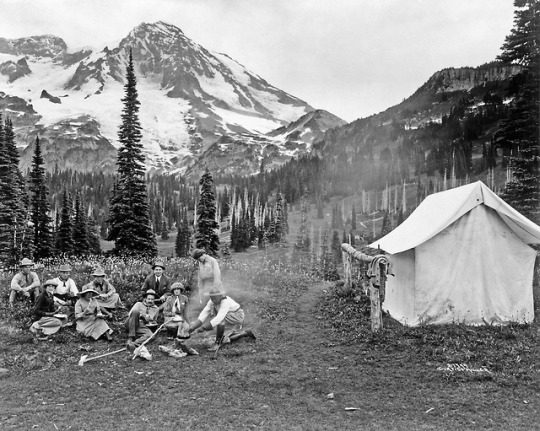
Nothing quite like a shared meal among friends!
Indian Henry Hunting Ground, Mt Rainier National Park, Washington 1911
87 notes
·
View notes
Text
Tracking the steps of the Deer Dancer
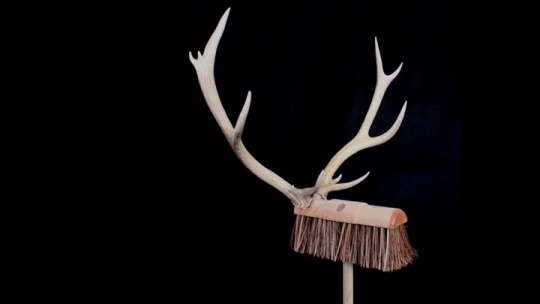
Some years ago, in Southern Arizona, a friend advised me to beware of the desert's spiky plant life. Sure enough, wandering the zigzagging paths through the canyon, I found myself picking fine spines from my clothes and skin. Learning to minimise this risk, I started paying attention to the ground and noticed human trails intersecting with animal tracks – javelina, coyote, and especially deer. With no rain for weeks, hoofprints remained debossed in the dry earth, like chains of split hearts, or strings of letters. Where clusters of tracks had accumulated, it looked as if the deer had been dancing.
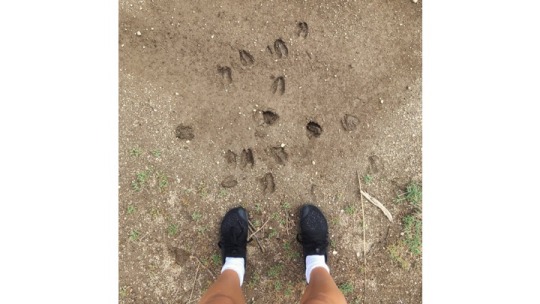
During that same visit, I came across a copy of the book Yaqui Deer Songs / Maso Bwikam: A Native American Poetry, edited by Larry Evers and Felipe S. Molina. Originally from the Río Yaqui, the indigenous Yaqui (or Yoeme) people now reside across the divided borderlands of Sonora, Mexico and Arizona, USA. I read that before setting out to hunt, their ancestors held a festive rite, enacting the wilderness world through a series of songs that address the deer, asking forgiveness for those animals that will die. Though hunting is rarely practised by present-day Yaqui, traces of the tradition remain extant in the Deer Dance, wherea single male dancer becomes the Maaso– the deer – and, wearing a stag headdress, he imitates the movements of a white-tailed deer.
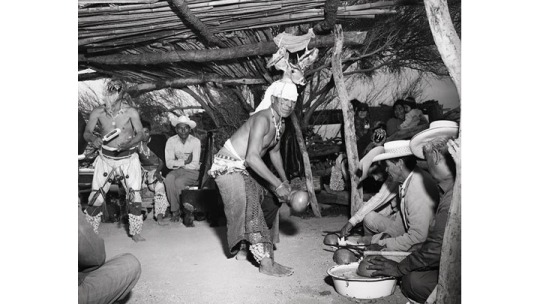
I was struck by the ways in which the photos of the costume bore a resemblance to some images I'd seen of the antlered headdresses found at Star Carr, a Mesolithic site in Yorkshire. Archaeologists have suggested that these red deer frontletswere worn in hunting rituals, allowing the wearer to harness antler effects, gaining access to the perspective of the 'animal-in-action'. Could this also be true for the Yaqui Deer Dance?
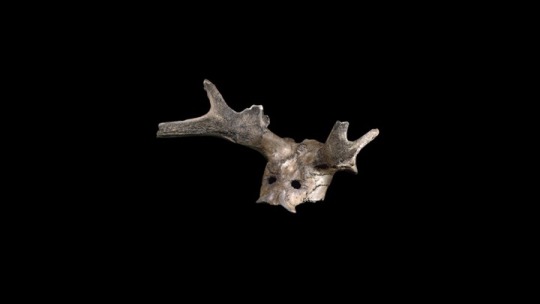
Pondering these connections, I recalled two dances I'd heard about in the British Isles – the Abbots Bromley Horn Dance of Staffordshire, believed to be a memory of a celebration of villagers’ hunting rights, featuringsix men bearing mounted antlers said to move like deer, and the Scottish Highland Fling, thought by some to have its origins in a warrior’s dance imitative of deer, with hands held aloft for antlers.

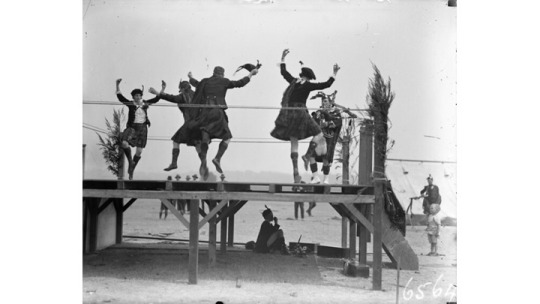
'Mimesis' – the imitation or emulation of the more-than-human-world – in traditional music and dance is something I've explored over the years, from Scottish Gaelic vocal imitations of birds, to the practice of embodying a river in South Indian Kutiyattam movement. I was keen to find out more and studythese three'deer dances' in tandem.What kind of deer effects are harnessed in these dances? Which deer behaviours are imitated and why? What do they reveal about our relationship with deer and ecology?
Over the next couple of years, I made numerous field trips to observe dances, interview practitioners, and learn steps directly from tradition bearers. Spending time observing deer, I consideredthe ways in which their behaviour is emulated in the dances and, learning about the ecologies of their habitats, I examined their relationship to hunting, stalking at Trees for Liferewilding estate in Dundreggan, and animal tracking in the Sonoran Desert. I was particularly interested in exploring the 'tacit' knowledge embodied in the dances. What could be discovered by 'learning' and 'doing' these dances, as opposed to just 'watching' them? What could be discovered in the body, through practices of stalking and tracking, instead of simply 'reading' about them?
Needwood Forest, Staffordshire...
I first went to see the Abbots Bromley Horn Dancein September 2017, and then again in 2018. This folk dance takes place once a year in the Abbots Bromley village, near to Bagot's Wood, an area of woodland just one and a half square miles, which is all that remains of the ancientNeedwood Forest. Like most forest in Britain, historically it was property of the Crown and, in this case, was once parcel of the Duchy of Lancaster.
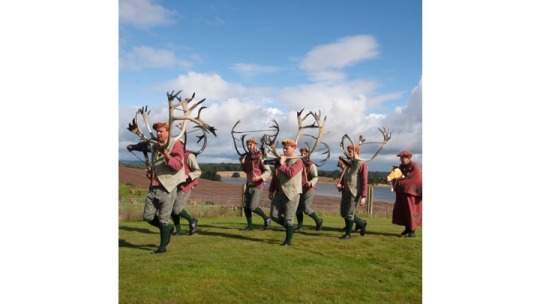
Today the word 'forest' refers to an area of wooded land, but the medieval sense of the word referred to land set aside for royal hunting. The 'Royal Forest' included large areas of heath, grassland and wetland, essentially anywhere that supported deer and other game.Villages and towns that lay within it were subject to forest law, protecting the 'Beasts of the Chase' from being hunted by anyone except the king, safeguarding the habitat in which they lived. These 'beasts' were primarily deer, and included native red and roe deer, as well as non-native species such as fallow deer, introduced to England for the very purpose of hunting.
Every Royal Forest in England was overseen by a keeper who was appointed by the King, and whose position was often hereditary. Forest Law meant that it was illegal to hunt deer, chop down trees or underwood, unless permission had been given by the Crown. Penalties for offenses were severe, but by 1217, the death penalty for poaching had been abolished. This didn't stop some kings; during the reign of Henry VIII, a yeoman named Richard Horne was caught poaching deer in the woods and was hung for his crimes. His ghost, known as Herne the Hunteris said to haunt Windsor Forest, with antlers growing from his head and chains rattling behind him.
Within the structures of Forest Law, payment for access to certain rights became a useful source of income and local nobles could be granted a licence to hunt an agreed amount of game, giving forest inhabitants a variety of rights. As I mentioned, theAbbots Bromley Horn Danceis believed by some to be a memory of a medieval celebration of villagers’ hunting rights, possibly recalling the act of giving thanks to the local nobility for access to the Royal Forest. Others believe it was danced to ensure a successful hunt, or a good harvest. The forest itself was largely lost in the eighteenth-century due to deforestation. With all this in mind, I couldn't help but think that the Horn Dance was taking place in an imaginary landscape, in the ghost of a place that no longer exists.

The dance itself featuresten dancers: six deer-men carrying mounted antlers, a hobby horse, bow-man with his bow and arrow, Maid Marian (or man-woman) with their stick and ladle, and the fool with his pig's bladder. The antlers are mounted onto carved wooden deer heads at the end of sticks, reminiscent of a child's hobby horse toy. Surprisingly the antlers are not native; carbon dated to 1065, they came from reindeer, long extinct in Britain.
At eight in the morning, after collecting the horns from the church, the ritual begins. Moving in procession, the horn dancers exit the church yard and, on a street corner in the village, they perform a sequence of steps, circling and winding in time with the accompanying music performed on melodeon and triangle. Though stylized, particular movements are especially mimetic. Recalling the rutting behaviour of a number of species of deer, the dancers move together in a parallel walk, and then face one another, moving towards and away, passing through, as if clashing antlers during a fight. Followed by villagers and visitors alike, the horn dancers and their musicians proceed to beat the bounds of the village, walking over ten miles throughout the day, performing at each farm and pub. Taking a drink at every stop, as you might imagine, banter follows, with jokes erupting at every turn. The music is constant and consistent and, soon enough, I found myself humming along with the tunes. The sound of the triangle was particularly affecting, cutting through the cacophony of sound.
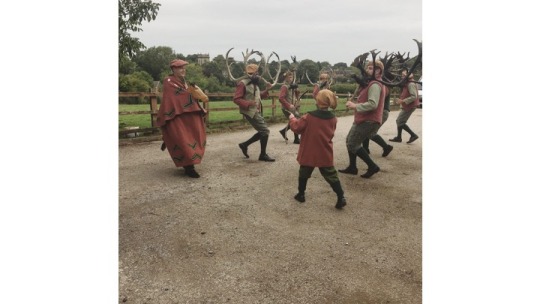
At Blithfield Hall, the tone changes considerably. The hall, a Grade 1 listed country house owned by the Baggots, has been in the family since the 14th century. The horn dancers perform on the lawn outside and when the music stops, they stand in line and wait. The Lord and Lady of the house then proceed to shake each dancer's hand, while the audience looks on from across the boundary wall. In a legacy of class inequalities, the memory of a celebration of hunting rights becomes particularly visible. Back in the village, the dancing finishes at about eight pm, when the horns are returned to the church, to be hung on display until the following year.
During the dance, I met Jack Brown, a tradition bearer and local historian, now in his nineties, who was dressed as a fool in yellow tails. He explained that he had "played all the adult parts" in the Abbots Bromley Horn Dance – deer, hobby horse, fool, man-woman and musician – and invited me to visit him at his home, a treasure trove of photos and objects, including props from the dance – a pig's bladder, triangle, bow and arrow, and stick and ladle. Jack shared with me his memories and knowledge of the dance's history and gifted me a pamphlet on his interpretation of it.
The horn dancers themselves are also very generous, opening up the floor – or ground – to participation, and over the two years I visited, I took part in a number of dances, giving me direct insight into the movements, shapes and step formations, as well as an embodied understanding of the sheer weight of the horns. Weighing between sixteen and twenty-five pounds, it is physically difficult to dance with these objects, to carry and move with them. Reindeer antlers are larger than red deer – our biggest native species – and if, as it has been suggested, they were imported from Scandinavia, perhaps we could say that the dancers of yesteryear were attracted to their size, in order to 'harness their effects'. What are these effects, I wondered? The size and weight of the antlers certainly enhances a performance of physical strength, perhaps showcasing 'heroic' abilities of endurance. During times when hunting was commonly practiced, these were presumably important attributes.
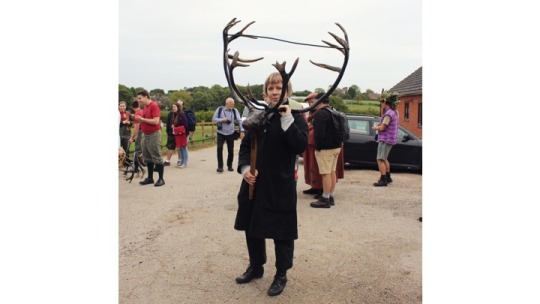
The props are most deer-like during the 'fighting sequence' when the antlers become like weapons between three pairs of rutting deer-men, albeit in an incredibly stylized rut. Some folklorists have posited that the Horn Dance was a fertility ritual; the antlers in this case would be symbolic of the male sex organ. Was this a mimetic display of the stag's bravado? Certainly, at some point, multiple powerful effects were being harnessed.

Back in the studio, I began to make sketches, tracking the shapes made on the ground by the dancers in a series of visual scores. Returning the following year, I showed my score sketches to Jack, and to Jim, a deer dancer whose family, the Fowells, have been performing the Horn Dance since 1914 after it passed to them from the Bentleys – interestingly, the Bentley family were historically the foresters of the local woodland. Checking the shapes and patterns on the page, Jack and Jim approved my visual notations, confirming their accuracy.
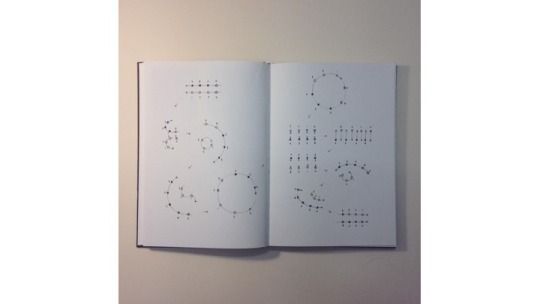
My notation process was also supported by a surprisingly fortunate booking! Reserving a room in a local B&B that looked down onto the area of the final dance, I was able to film it from above and compare the footage with my scores.
Caledonian Forest, Scotland...
The Caledonian Forest, characterised by Scots Pine trees, was once a huge forest stretching across Scotland. About 6,000 years ago, as the climate became wetter, some of the forest began to disappear, but the impact of human beings was even greater; trees were felled for ships, buildings, fuel, and to make way for agriculture. By the 1700s, the Caledonian Forest remained only in the most remote places and much of the wildlife that depended on this habitat was lost through hunting, or simply because there was not enough forest left. The last wolf is said to have been shot in Scotland in 1743, which meant that by this point, all of the predators had been wiped out. In fact, all of the largeanimals had gone, leaving only the red deer. Since then, this animal has come to symbolise the Highlands.
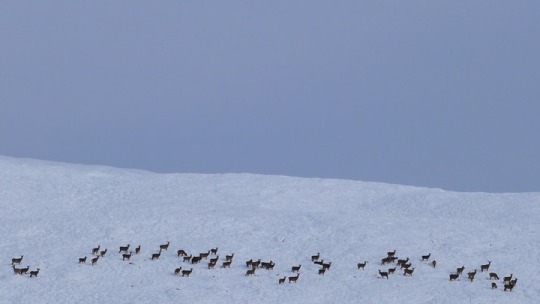
In the 19th century, as deer stalking became fashionable, large tracts of land were dedicated to deer, allowing their numbers to increase, and ‘deer forests’, which are essentially open hills managed for deer, doubled in size. Today, many Highland estates still maintain large deer populations for stalking purposes and the current number is estimated to be 350,000 individuals. Through their excessive numbers and overgrazing, deer are often seen as the problem that prevents the regeneration of the Caledonian Pinewood, however, the ecological imbalance between native forest cover, numbers of grazing deer and lack of natural predators has been caused by humans, not deer.
Trees for Life acquired their Dundreggan estate in 2008, and since then, they have been rewilding the land, planting new trees in places, such as higher mountainous areas where it is difficult for trees to establish on their own, and reducing grazing pressure to allow the forest to recover and regenerate, which, inevitably, involves the culling of deer. In 2017, I went to stay in Dundreggan, and went out stalking with Allan Common, the lead deer stalker on the estate. It was autumn, which in the red deer calendar, meant this was the time of the rut. Meanwhile in the stalking calendar, it was the time for hunting stags. I wasn't sure whether this seasonal stalking tradition was due to the fact that a rutting stag, full of high levels of testosterone, was less alert and easier to hunt, or whether it was because this hormone surge meant that the stag was now adorned with a large mane and antlers, and so more desirable as a trophy. Doug Gilbert, the operations manager at Trees for LifeDundreggan suggested that perhaps it was a mixture of the two – a legacy from the stalking craze.
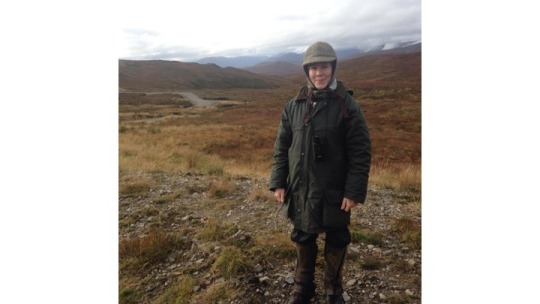
Dressed in a ritual costume of wax jacket, gaiters and tweed deerstalker hat, at 7am I was met by Allan and two of his friends. Up on the hill, he instructed us to move as one body, then, as we got closer to the deer, he showed us how to lie on our bellies and remain hidden. At the edge of a ridge, we stopped to look down into a bowl-shaped area. The distant sound of roaring stags reverberated into the cold morning and, for a brief moment, through binoculars, I watched as two mature stags walked in parallel, checking each other out, before lowering their antlers, initiating contact. Throughout the morning, Allan, or one of his friends, would position a gun, then using its view finder, take a shot. Sometimes this awkward movement alerted the deer to our presence, so to counter this, Allan skilfully mimicked the bellow of the stag with his voice, to keep the stags interested. It worked! – at one point, a mature male drew very close, standing only a metre or so away. Concealed safely behind a boulder we listened to his spine-tingling roar. My heart beat fast.
While staying with Doug and his partner Joyce, a fundraiser at Trees for Life, I learned more about their work. In order to regenerate the Forest, as well as the practical task of planting trees, they explained that there needed to be a shift in values, from "seeing the land as a place for deer, to seeing the land as a place with deer in it". On the estate, it does feel as though this is happening. When I asked Allan what the biggest changes have been in his job as a stalker, he explained that it was his shift in perception; he used to think the deer were the most important thing, but now he values the land in itself, the ecology as a whole. He told me about an earlier job, working for a sporting agency, where people pay money to go shooting, but had realised some time ago, that he didn't like this 'trophy culture'. He preferred instead to have a relationship with the place, and recounted lying on his back, watching as a golden eagle flew over him, just metres above his body. His most treasured memories were not to do with stalking itself, but a connection with the more-than-human world.
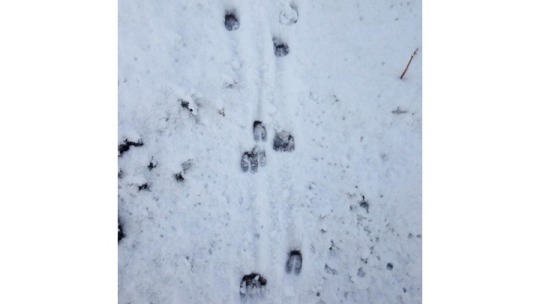
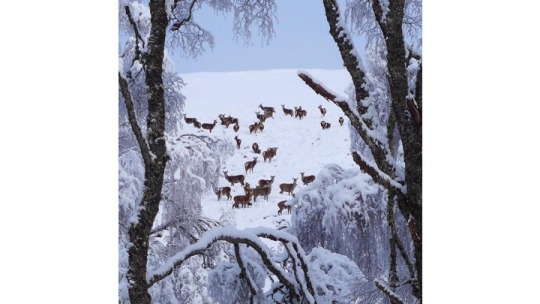
In February, when I returned to Dundreggan, there was heavy snow on the ground, and the deer tracks looked as though they had been debossed, not in earth but in thick white paper. It was the season for stalking red deer hinds, which, like the stags, were hunted in the morning. Night time was reserved for stalking the sika deer, an 'invasive' species from Japan. Being nocturnal, with a tendency to stay hidden under tree cover, they were difficult to spot. Allan used a combination of traditional tracking and an infrared thermal camera to find them. I began to reflect on the relationship of technology to the traditional costumes worn in the various dances, specifically in relation to the red deer frontlets found at Star Carr. Archaeologist Chantal Conneller has posited that these frontlets extended the body of the wearer, allowing them to "harness the animal in action", expanding their perception, essentially becoming-with-deer in order to hunt them. The user of the hunting rifle, with telescopic view finder and infrared thermal imaging also extends the body and perception, augmenting and expanding the senses, extending what is possible as a human being.
Allan may have used up to date technology, but he didn't appear to display any of the macho behaviours I had expected. His friends, however did, and on occasion, I felt uncomfortable. One ex-military friend, in particular, was keen to tell me all about his rifle throughout the stalks, even making me pose for the camera after a successful shoot. This macho sporting chat is not unusual in Scotland, in fact, it is part of mainstream stalking culture. After all, on most estates, the land is maintained as a 'wilderness' resource for deer, which supports an elite hunting economy for the privileged few – mainly rich cis white men on shooting holidays, collecting their trophies. This macho aspect of stalking is reflected in the language; the 'monarch', for example, is a term used to describe a mature stag with sixteen tine antlers, and thus the most prized trophy. Similarly, the language of animal behaviour studies is also gendered, and arguably problematic; the word 'harem', for example, is used to describe a group of female deer sharing a single mate.
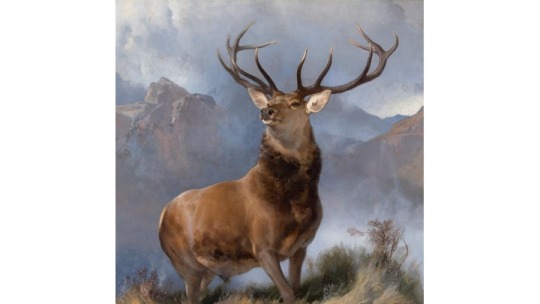
Deer stalking itself is steeped in myth and folklore. Geographer Hayden Lorimer writes: "The pursuit of deer, both as a pastime and as a livelihood, has a long history in the Scottish Highlands. Celebrations of these activities, preserved through several centuries in native Gaelic folklore, oral ballads and apocryphal yarns, were seized upon by the authors of stalking guidebooks, histories and personal reminiscences." Scottish 'deer' folklore was mined and appropriated by the cultural elite, giving deer stalking culture seeming authenticity.
The Highland Fling seems to be part of this process of appropriation. The story goes: Legend tells of a boy who encountered a stag; his father asked him to describe what he saw and, lacking adequate words, he danced the animal instead, his movements imitating capering, his hands held aloft for antlers. Becoming popular as an authentic dance of the highlands, it seems that deer mimesis gave the Fling credibility, but after some digging, I discovered that the story is more than likely a bit of 'fakelore' and probably invented by an eighteenth-century, Lowland dance teacher as a caricature of a 'wild' highland warrior who imitates deer. I couldn't help but think that this 'fakelore' shares striking parallels with the romanticisation of deerstalking, itself a mimetic performance of hunting traditions, reinterpreted and distorted into a form of macho display by landowning classes.

In Spring 2018, I began my studies in Highland Fling, taking lessons with dancer and teacher Sandra Robertson in Kinguisse. Sandra gave me a pair of leather ghillies – soft shoes traditionally worn in Highland Dance. Strangely, the word 'gillie' also means 'hunting guide' or 'male servant to a Highland chieftain'. The shoe's name is thought to be a type originally worn by Scottish hunting guides, who were servants to the lairds – there it was again: the working-class highlander at service to the landowning class and to the elite hunting economy.
I put the shoes on over my thick red socks and Sandra showed me some basic steps. Having done ballet up until the age of 19, I was accustomed to jumping, but the first thing to get used to was landing on the balls of my feet. This took some practice and on the evening after my first session, my shins were agony. Slowly, with time, I got used to it, and before long, I had learned six steps: shedding, rocking, toe and heel, backstep, crossoverand last shedding. It took me months of practice to get through the whole dance without stopping – it was exhausting! Anyone doing this dance regularly, had to be extremely fit.
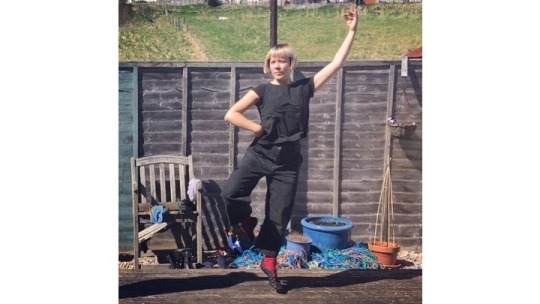
To help with my learning, I made visual scores of the dance, replacing arm positions with red deer antlers, and human foot fall with red deer tracks in a notation of the steps. I also began to experiment with blind debossing, inspired by seeing the tracks in the snow.

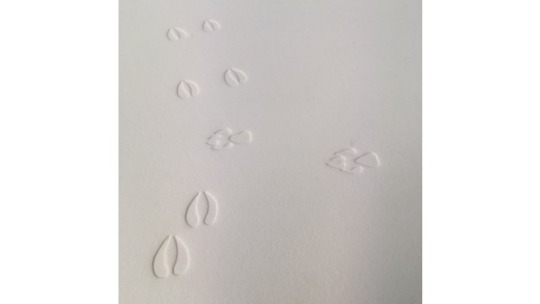
Romanticisation aside, learning the Highland Fling, I could understand why the story of deer imitation stuck. While dancing with deer in mind, the arms, when held high, felt like antlers. The steps, such as toe and heel, backstep and rocking were delicate and deer like, yet powerful and athletic. Two of the steps sheddingand last shedding seemed even to reference the stag's antler shedding, which happens once a year. I could imagine that if a dancer of the Fling performed well, it might make them feel powerful and elegant. I wondered how it might feel to perform this dance if I were a man?
Sonora Desert, Arizona and Mexico...
The indigenous Yaqui, or Yoeme tribe are originally from Sonora in northern Mexico. Seeking refuge from persecution by the Mexican Government in the 19th and early 20th centuries, some of this community were forced north of the border. Their descendants in the USA call themselves the Pascua Yaqui, and in 1978 they were finally recognised as an official tribe. Today, the Pascua Yaqui have eight communities in Southern Arizona.
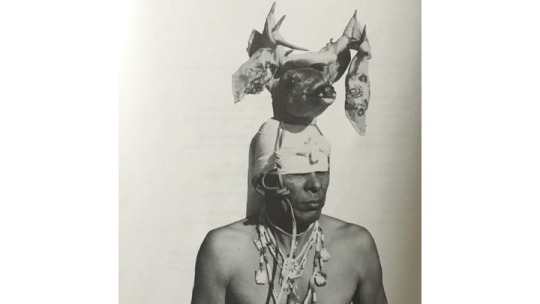
The Yaqui Deer Dance is a small but important element in the modern Yaqui ceremonial cycle, a ritual involving dance, music, pantomime, and poetry, in a complex blend of catholic and indigenous beliefs. Yaqui traditions speak of the Deer Danceonce being part of a rite performed before the hunting of the deer, but today that connection is only a memory.
Supported in part by the University of Arizona Poetry Centre, in March 2018, I went back to Arizona to begin to make connections with the Pascua Yaqui community. I met with Larry Evers, who co-authored the book on Yaqui Deer Songs mentioned earlier. He was about to retire from his role as a professor between the English and American Indian Studies departments at the University in Tucson, and when I visited, he was clearing out his office. Generously, he gifted me a pile of books and papers on Yaqui culture, as well as a set of DVDs with hours of footage of a Deer Dance ritual performed in Mexico in 1976. Of particular relevance to my research was an old type-writer written thesis, in which the writer Susan Burton explores the relationship of the Yaqui Deer Dancesteps to the movements of real deer and, using the 1976 film footage, notates the dance's vocabulary with labanotation.
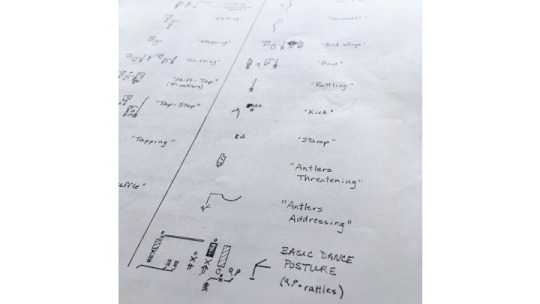
Larry was excited by my research, though warned me that I would have many boundaries to cross. Firstly, my gender – the Yaqui Deer Danceis strictly a male domain – and secondly, my ethnicity as a white European. As with many First Nations people, the Yaqui tribe have been consistently ill-treated by various outsiders throughout history, from the invasion of the Spanish Jesuit missionaries and the Mexican Government's persecution of indigenous tribes, to the early American anthropologists misquoting traditions, and the US authorities' mistreatment of anyone who is not white. Understandably, the Deer Dance, and Yaqui culture more broadly, is rarely discussed outside the community.
I was readying Donna Haraway's book 'Staying with the Trouble' and the following passage resonated:
"Indigenous peoples around the earth have a particular angle on the discourses of coming extinctions and exterminations of the Anthropocene and Capitalocene. The idea that disaster will come is not new; disaster, indeed genocide and devastated home places, has already come, decades and centuries ago, and it has not stopped. The resurgence of peoples and of places is nurtured with ragged vitality in the teeth of such loss, mourning, memory, resilience, reinvention of what it means to be native, refusal to deny irreversible destruction, and refusal to disengage from living and dying well in presents and futures."
I wondered if it was possible to foster a meaningful dialogue and cultural exchange? To open up possibilities, Larry put me in touch with his long-term collaborator Felipe Molina, a Yaqui tradition bearer, teacher and translator, from Marana, Arizona. We exchanged emails and, though Felipe was interested in my research, he was too busy with his Easter commitments as a Deer Singer. We agreed to be in touch again later in the year.
During the Easter ceremonies, the Yaqui Deer Danceis held on two occasions, at the Pahko– an all-night Fiesta – and then again on Easter Saturday. Seeking permission to attend these, I contacted Daniel Vega from the Language and Culture Departmentof the Tribal Council at the Pascua Yaqui Reservation. At our meeting, I explained how I was exploring the imitation of deer across cultures in order to better understand their relationship to ecology and, sharing a little about my research so far, I was delighted when he showed a particular interest in hearing about the Abbots Bromley Horn Dance. He explained that the Yaqui tribe perform their various ceremonies as healing rituals, not just for the Yaqui, but for everyone around the world, so, if I went with respect, I was welcome to attend the Easter ceremonies at Old Pascua– the old village in South Tucson. He warned me not to take photos, make sketches or any recordings – this was strictly forbidden – and that I had to keep my cell phone out of sight.
Not quite knowing what to expect, on Friday evenings I began to attend the Lenten ceremonies, participating in the processions of the fourteen Stations of the Cross, following the various church groups who sang and prayed at each of the crosses positioned around the Old Pascua village. Also partaking in the processions was a ceremonial group called the Fariseos, who are said to represent those who persecuted Jesus. Within this group were the Chapayekas– masked figures who symbolise evil. One of the Chapayekas'ritual functions is to deride the procession and distract the church groups by silently mocking them, beating time with swords and daggers, and shaking the deer hoof rattles around their waists and moth cocoon rattles on their ankles. My initial reaction was to laugh at their pantomime-esque performance, but as the sun went down and the procession continued in darkness, they really felt quite sinister. I soon discovered that it is taboo to stare too closely at a Chapayeka.
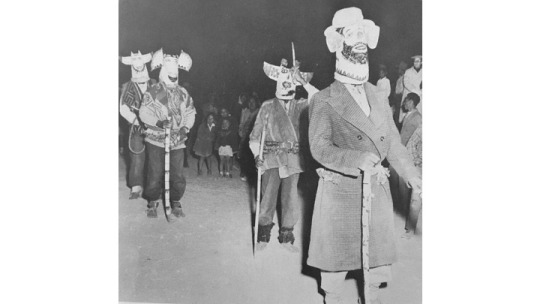
On Palm Saturday, I attended the Yaqui Pahko. Though I'd read so much about it, nothing could quite prepare me for the experience of this multifaceted, powerful night-time ritual. Approximately two hundred performer-participants, divided into about twelve groups, each with a distinct role and music, carried out ritual processes and costumed dances representing the various overlapping forces of good and evil. There was only one Deer Dancer though; at the Ramada, a structure symbolising Huya Ania (the wilderness world), the Maaso(the deer dancer) emerged as a timid fawn and, dancing alongside the Pahkola(a group of clown-like animal-esque figures), he slowly grew into a virile adult male through the night, before predicting his own death and concluding his dance as an animal spirit.

During a break in the ceremonies, I chatted with someone I'd met in the 'audience' who made a striking observation about how the Maasoalways has his torso tilted forwards, like the enigmatic Palaeolithic ‘sorcerer’ cave painting of the Trois-Frères caves in Southwestern France. I hadn’t made the connection before, though I had stuck an image of the ‘sorcerer’ in my sketchbook. The visual similarity is uncanny – was this how humans become-with-deer?

A similar sequence of Deer Dances took place on Easter Saturday, another complex, multi-layered ceremony, where, in a battle against evil, the powers of the more-than-human world were harnessed. Dancing Matachiniswore flower streamers in their hats, processing Angels waved branch-switches in the air, trickster Pahkolas wore animalesque masks, and, the Maaso (Deer Dancer), in his final dance, charged at the Fariseos, threatening with his antlers. Finally, when evil was defeated, the Fariseoswere ritually ‘killed’ by 'flowers', symbolised by paper confettithrown at them, and a straw ‘Judas’ was burned in a fire, along with all the Chapayekamasks and swords. Bells rang out from the church and celebratory music was played. With so much colour and joy, I felt like I never wanted to brush the confetti out of my hair!
In a closer examination of the Deer Dance itself, the combination of the dancer's movements and costume seems to span a spectrum of mimesis, from iconic deer imitation to something more stylised. The deer's headdress enhanced the sudden sharp-to-still deer-like movements of the head; soon enough, I found myself watching not the dancer's eyes, but the deer's eyes, partially hidden beneath the cloth. The long line and tension of the tilted torso suggested a deer's back, and the white cloth joining the dancer's head and deer head gave the impression of a deer's neck and shoulders. The flexed feet were reminiscent of the animal's hind legs, while the gourd rattles suggested the front legs, the movements of which gave the impression of a deer's speed and agility. The footwork itself – the choreographed steps – seemed less iconic and more stylized. I wondered if I would be able to meet and learn from a dancer some time...
The dance is traditionally accompanied by three musicians who sing and play instruments: the hirukiam,notched rasping sticks resting on half-gourd resonators said to represent the deer’s breath or the scraping of the antlers against the brush, and the ba’ abweha’i, a water drum made from a half gourd floating in a bowl of water, representing the heart-beat of the deer. Sitting on the floor during the dance,I could feel the vibrations of the water drum in my chest, and I imagined that the dancer might be tuning his heart into a deer's heart beating.
The songs accompanying the dance, are sung in Yoem noki(the Yaqui language) and describe the Maaso(the deer) and his encounters with other animals, birds, insects and plants, especially flowers, which hold a spiritual significance. The Yaqui believe that there is a close communication between all the inhabitants of the Sonoran Desert, which they call Huya Ania. This could be translated as 'wilderness world', but it is worth pointing out that the word 'wilderness' here, does not mean a "neglected, uninhabited, or inhospitable region" like it does in the Oxford Dictionary, but a living, connected community. This ecology of the Sonoran Desert appears in the traditional songs, which become like scores, or a script to the dancer who, as the deer, also becomes, for a moment, the badger that is being described, or the hummingbird, or the mountain lion.
Later that Summer, I returned to meet with Felipe and, over a number of meetings, learned more about the dance. We shared our perspectives and he generously answered my sprawling questions, teaching me about aspects of Yaqui culture, including some Yoem nokiwords. Felipe explained how the Deer Dance was a way for people living in the city to connect with Huya Ania (the wilderness world) and Sea Ania (the flower world), and as he described how the songs are lessons for listeners to learn about ecology and Yoeme ancestors, I began to think of the Yaqui Deer Dance as a form of activism.
I was honoured when Felipe invited me to give a talk to his students, a class of young Yoeme adults, who were learning about their culture at the Yaqui tribal chambers on the reservation. I shared a little about my work with vernacular traditions, specifically Scottish Highland culture and language, and about the history of the repression of Scottish Gaelic and the current resurgence of the language. It was good to hear Yoeme perspectives. Though the Yoem Noki language is under threat of dying out, people like Felipe are out there doing the work of preserving and passing on knowledge.
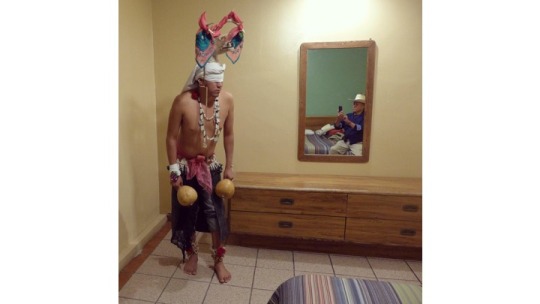
Felipe and I began to make plans to visit a Deer Dancer in Mexico later in the year and, in November, over a number of days, we went back and forth by foot across the Mexico-USA border, to work with Indalecio ‘Carlos’ Moreno Matuz, a young Yaqui Deer Dancerfrom Vicam, Sonora, in the Yoeme homeland. We worked in Carlos’ hotel room, where I interviewed him and learned about the physical and symbolic aspects of the dance through demonstrations and diagrammatic drawings, while Felipe translated from English to Yoem Noki and back again.

Felipe and Carlos explained that the dance had only ever been performed by men because they were the ones who traditionally went hunting. Interestingly,the deer behaviours imitated were less about the bravado and display associated with the rut, and more about alertness and agility as a form of defence. This corresponds with the fact that in Yoem Noki, there is no word for 'buck' or 'stag'; Maasosimply means 'adult male deer', though his other song names are displayed here. The only time the Maasodisplays aggressive behaviours, such as charging or threatening with lowered antlers, is when he is being attacked or provoked by other figures in the ceremonies.
The white-tailed deer – and coues-white-tailed deer – live in areas of the Sonoran Desert – a land that rambles over 320,000 km, across two countries. It is home to about 130 species of mammals, more than 500 kinds of birds, 20 amphibians, 100 or so reptiles, 30 native freshwater fish. There are perhaps as many as 2500 native species of plants and 4000 in total. It is also home to at least 17 Indigenous cultures as well as many others who have adopted it.
The tribal lands of the Yaqui have been irreversibly damaged, initially due to the European invasion and colonisation, and latterly by the rapid growth of capitalism and climate change degrading the ecology. Along the Yaqui River in Mexico, eight tribal villages have no water due to drought and the actions of agricultural corporations and, every year, people battle with wild fires caused by rising heat levels and invasive grasses spread by cattle. Although the culture of the Yaqui Deer Danceis being preserved, the ecology of the wilderness world is seriously under threat.
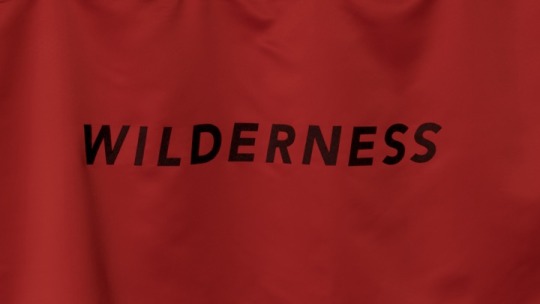
Wild-deer-ness
Throughout the process of exploring these dances, I considered how a body of work might emerge from my research. By conjuring the antlered male deer, the dances evoke images of wild nature, but I realised there is a disconnect between what is encoded in their movements and the reality of local ecology. I was also acutely aware of the striking relationship between our cultural perceptions of 'wilderness' and ideas of 'masculinity'.
How could I honour these folk traditions and histories, yet simultaneously critique and de-stabilise constructed problematic narratives? How could I address contemporary intersections of ecology, gender and class? How could I touch on the complex relationship between indigenous cultural knowledge and the appropriation of vernacular culture? What did I want to explore and communicate?
I spent time writing, thinking, dreaming and in my note books began to distil my research into words:
From Palaeolithic cave paintings, to Landseer’s Monarch of the Glen, throughout time, artists have made representations of deer. Whether as staples to hunter-gatherers, icons of power and empire, or the focus of sport, deer have long been central to human cultures.
In popular imagination, deer remain etched into people’s consciousness as emblems of the 'wild' – the word wildernessitself, derives from the Old English wilde, wild, and doer, deer – and our relationship to the idea of wild-deer-nesshas shaped the landscape. Transported across continents, some species, such as fallow and sika deer, transformed ecologies with the establishment of royal deer forests and parks – hunting grounds belonging to the Crown. Other species, such as the reindeer of the arctic tundra and white-tailed deerof the Sonora desert, face threats of habitat loss caused by climate breakdown. In Scotland, the overpopulation of red deer due to human made environmental change impacted greatly on the degradation of Caledonian pinewood ecology.
And so, it follows, although they are perceived as powerful, deer also embody vulnerability. Constantly alert to the threat of a hunter or predator – or the ‘ghost’ of an extinct predator – they inhabit vulnerable places. It could be said that deer do not live in wilderness, but in ghosts of places that no longer exist.
Across timescales and cultures, our relationship with deer as a totemic and ideologically powerfulanimal has contributed to a construction of wilderness as an imaginary landscape, setting 'nature' apart from 'culture'. Is it possible to shift our relationship to the world and renegotiate these dichotomies?
The dancers at Star Carr, the Abbots Bromley Horn Dance, the Yaqui Deer Dance and the Highland Fling are separated by geography and time, yet there is a commonality in these seemingly disparate cultures, which find echoes throughout history, fromthe ritualised carrying of stag heads condemned by medieval European church leaders, and Herne the Hunter, the antlered ghost of a royal gamekeeper in English folklore, to the Tibetan stag-headed Chamdance and Shishi-Odorideer dance of Northeast Japan.
Evolving over generations, each dance is mimetic in some way, with movements that imitate male deer behaviour and gesture, from the frolicking of the fawn and the alertness of the adult male, to the bravado, display and aggression of the rutting stag.Costumes also play a significant role, and often, but not always, feature elements of attire made from animal parts. Another common feature is that they are (or were) traditionally performed by men and, with their displays of muscular strength and athletic endurance, they are all thought to have their origins in (or associations with) hunting ritual practices.
As traces of hunting rites, how are these dances to be understood within a contemporarycontext?
How does the mimesis of male deer behaviours inform a 'performance' of masculinity by male dancers? What are the implications of these gendered performances in society today?
Returningto the animal tracks that obsessed me, back in the studio, I finished scoring the three deer dances I had studied, tracking the steps of the dancers, replacing human foot-prints with deer hoof-prints: red deer for the Highland Fling steps, white-tailed deer for the Yaqui Deer Dance steps, and reindeer for the Abbots Bromley Horn Dance steps. Working with Edinburgh Printmakers, I developed these into a series of blind debossed prints.
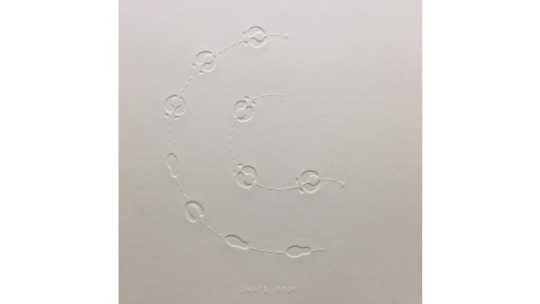
Becoming-with-deer
Considering different approaches to choreograph from the scores, I decided to draw upon the most mimetic aspects of what I had learnt and adopt fragments of steps to make something entirely new. But who would perform this? Drawing on multiple layers of my research, I began to conceive of a series of characters, each one a constructed assemblage of aspects drawn from a male-deer/male-human spectrum, playfully dissolving human:animal binaries. Making sketches of these figures, I gave each of them names borrowed from archetypal male characters found within traditional theatre, as well as deer and deer stalking terminology: monarch, warrior, young buck, fool and old sage.
To get to know them with my body, I decided to attempt to become each deer-man myself. By queering these figures, I hoped to challenge our constructed ideals of masculinity and question the mythologies that give authenticity to gendered behaviour. Having experienced some of the more negative and toxic behaviours of the heroic-hetero-male in my day to day life – let's call this thecrisis of masculinity– I also wondered if, by becoming these characters, I could release myself from their impact on me as a queer woman, and simultaneously bring to the foreground the impact of these behaviours – the crisis of ecology– on vulnerable and damaged habitats.
My plan became to create a moving image and sound work, performing each character in a choreography-to-camera. I began to collaborate with two performance artists: Peter McMaster and Will Dickie, who both practice at the intersection of live art and dance, and whose past work had, in various ways, explored tropes of masculinity, ritual and ecology. Peter collaborated with me on the film's dramturgy and Will became the movement director, helping to devise the choreography. Together, we discovered and developed the characters.
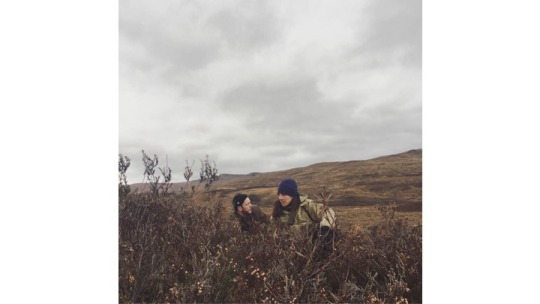
To begin our process, in October 2018, we spent a few days at Trees for Life, workshopping ideas and watching deer. We also went out deer stalking with Allan. This time I was very sensitive to his movements, almost reading him as a dancer, and was struck by the ways in whichhe took on qualities of the animal of the hunt, harnessing deer-perspective.Like the deer, he was quick to register distant movements and sounds and, on getting close to the animal, to remain hidden, he tilted his torso with bended knees, a pose strikingly similar to the Yaqui Deer Dancer's basic posture and cave painting of Trois-Frères.Will made an interesting observation about how the deer stalk appeared to be carried out in clearly defined ritualised stages. Beginning casually, walking upright and chatting, we slowly grew tighter as a pack, becoming quieter and more focused, tuning in to our surroundings and, as we drew near to the deer, we got close to the ground, not moving or making a sound, our bellies up against the heather. Before taking a shot, Allan spoke about a moment of stillness – a stillness of breath and of thought.
In a similar way, each dance that I had been studying, sat at a different stage in the ritualised drama of the hunt: the Yaqui Deer Dancetraditionally took place before hunting, allowing the hunter to access the perspective of the deer; the Highland Flingwas a dance of triumph, a dance to feel powerful and in control; and the Abbots Bromley Horn Dancewas a celebration after the hunt, to give thanks. With gestures that ranged from iconic imitation to stylized metaphor, these rituals of the hunt were clearly mimetic of the rituals of the deer rut. But how could the dramaturgy of my film address what felt urgent to me: the interconnections between the crisis of masculinity and the crisis of ecology? We slowly began to realise that if Deer Dancer was to function as a ritual space, perhaps the characters would have to stalk each other to the death...

Early the following year, Will, Pete and I worked together to discover the five characters from the inside, developing their movement vocabulary and training exercises and, as we explored the relationship between them, a story emerged. I began to conceive of a two-channel film and sound work that would play with, and attempt to destabilise narratives found both the within anthropology documentary and wildlife/nature documentary. To prepare for the filming process, I created a story board for the two screens, and composed and recorded a multi-layered vocal composition to perform to.
Utilised technology to 'extend my body' and expand my vocal range into 'male' and 'stag' pitches, I worked with my voice to imitate drum sounds. Recalling my experience of the Yaqui water drum, and the Abbots Bromley Horn Dancetriangle, my intention for the sound was to affect the viewer-listener on a body level, sometimes in a way that is unsettling, at other times like a heart-beat of low vibrations in the chest or belly. Alongside the process of developing the characters physicality, and the vocal score, I began to design and make the costumes and props, with invaluable assistance from my partner Lydia Honeybone, using an assemblage of materials, from ribbons and sequins, to bullets and hunting horn. I also worked with naturally cured deer hide, hooves, antler and skull, specifically for the cod pieces, and the weapons, hinting at the relationship between the posturing of male sexual bravado and violence.
We filmed over three days in Glasgow University's theatre against a black curtain. My director of photography Andrew Begg lit the space, and followed the story board shot by shot, filming each character one by one, then, in post-production, with editor Laura Carreira, I then pieced together the jigsaw puzzle.

Introducing the characters...
The Monarch is a mature, dominant male, who holds his head high, displaying his sixteen-tine crown and enlarged neck. Over his hide, he wears gold. His stance is wide and a bulbous codpiece with tassels enhances his majesty. Belling loudly, he asserts his authority, warning off rivals to his harem of hinds. But he's growing old and his limbs are becoming stiff. Soon he'll be past his prime.
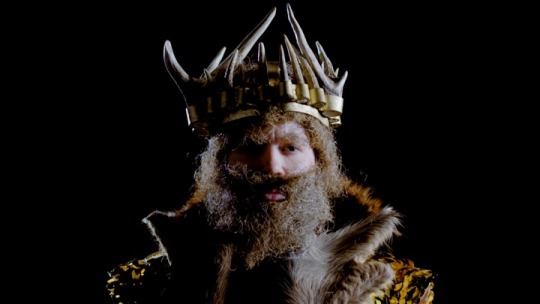
The Warrior is highly alert, his senses tuned into his surroundings. He tracks and hunts, defending himself on attack with antlered spears that extend from his shoulders. He's in his physical prime; his chest is hard and strong and over his tartan loins, he wears a sporran and bullet belt. When he hears his rival, he sounds his horn, displaying his power.
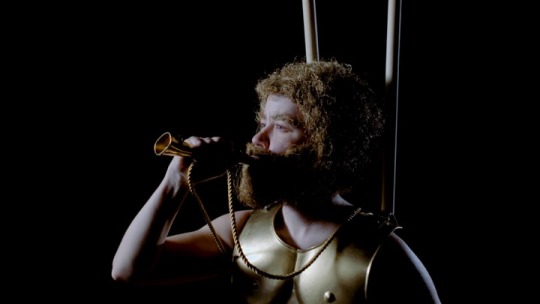
Though the Young Buck has reached sexual maturity, he's still a spiker, yet to win his own harem. But he's looking. Dressed in tweed trews and protruding codpiece, he taps the ground, addressing potential rivals. He is lustful, cocksure and trigger-happy, challenging anyone in his close proximity. Breathing heavily, he's on the hunt for a hind, on the hunt for a fight.
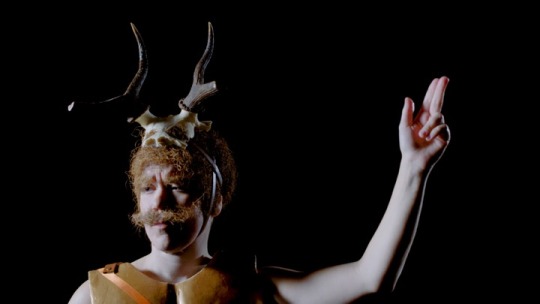
The Fool, small in stature, avoids the dominant males as they proclaim their authority during the rut, bawling and displaying his white behind in fear. Wearing ribbons, bells and a modest codpiece, he carries a broom with antlers, a hobby stag that appears to push and pull him into combat. Haunted by ghosts, this skittish staggard is bewildered by his own inner conflict.
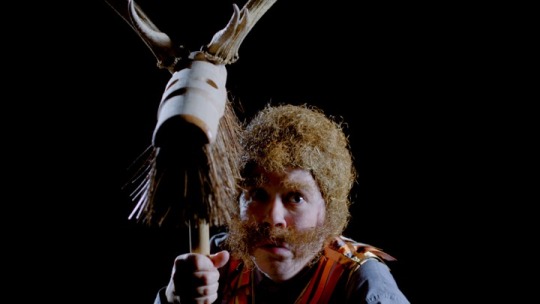
The Old Sage is a spirit of the wild hart and ghost of a man. Haunting the wilderness with skull and ragged horns, he relives his life tending the land with hooves and hands. He also relives his death. Only perceived by a few, he sees all.
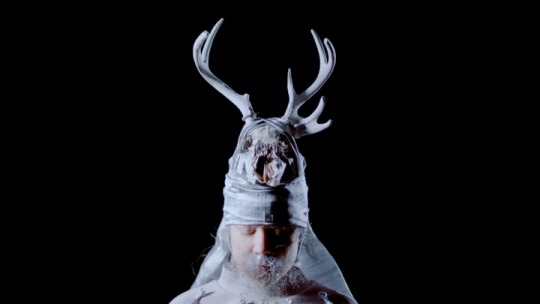
Deer Dancer
In the resulting work, the costumes, movements and music work together to tell a story, with the visual scores acting as hidden keys to the work. In the 'pop up theatre space' of the gallery, we meet the five characters in an imaginary wilderness world. This wilderness world is not rooted in a particular ecology, but is place-less, black and empty, allowing the viewer-listener to construct and project their own wilderness into the space.
A dynamic emerges between these deer men, and slowly they begin to stalk one another.Then, in a face-off, they lock eyes, take a bow and the deer dancecommences. With movements that signify both the deer rut and a pre-hunt ritual, the characters face one another, performing their ritual dance, with fragments of steps from the three dances. In the visual scores, these steps are delinieated in gold foil on the debossed tracks – interestingly, the word 'foil' also means 'animal track'.
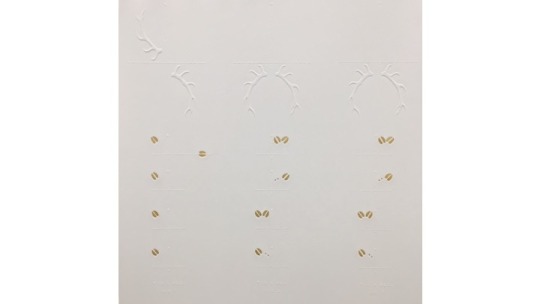
Then, coming to a stop, one by one, the deer-men draw their weapons, and we see each one lying in their death pose, with blood flowing from their body, signified by slow moving red ribbons. As bodies disappear (or decompose), the costumes remain as relics of culture to be performed again. Bit by bit, they too disappear, until then reappear on my body, piece by piece, reconstructing each character in a queer assemblage. And then it begins again...
Stuck in a perpetual loop of learned behaviour and appropriation, these stag-men are ultimately condemned to self-destruct. Humankind has left a footprint so deep that we are only now beginning to grasp the immensity of the calamity. In a small way, I've come to think of Deer Dancer as a contemporary life-crisis ritual for a damaged planet. But when the balance has been set right in ritual, the question becomes how do we really address the damage?
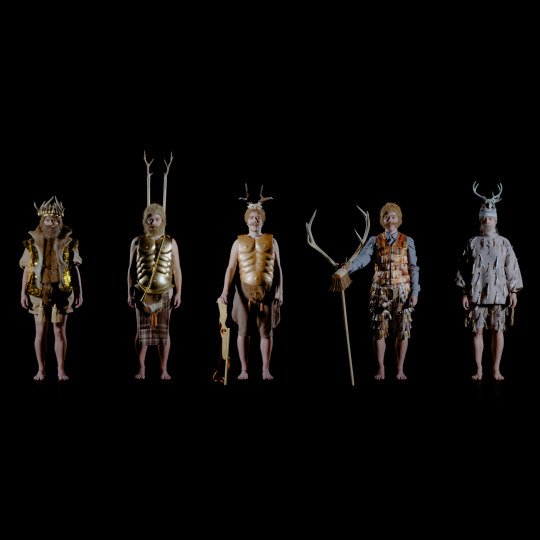
This text was originally written and presented as a talk at Edinburgh Printmakers in September 2019, to accompany Tuulikki’s Deer Dancer exhibition.
Deer Dancer credits: Performed & directed by Hanna Tuulikki; Character development and choreography by Will Dickie, Peter McMaster and Hanna Tuulikki; Dramaturgy by Peter McMaster; Movement direction by Will Dickie; Sound composed and recorded by Hanna Tuulikki; Sound mixed with Pete Smith; Director of photography by Andrew Begg; Edited by Laura Carreira; Costume fabrication assistance and wardrobe management by Lydia Honeybone; Production management by Amy Porteous; Costumes and print works by Hanna Tuulikki
Developed through conversations and interviews with tradition bearers and academics, Felipe Molina (Yaqui tradition bearer/ translator), Larry Evers (American Indian Studies, The University of Arizona), Jack Brown (Abbots Bromley Horn Dance tradition bearer/ historian), Doug and Joyce Gilbert (Trees for Life); by observing a number of dances and participating in rituals, including the Yaqui Deer Dance (Pascua Yaqui Easter ceremonies, Old Pascua, Tucson, Arizona, March 2018), Abbots Bromley Horn Dance (Abbots Bromley, September 2017/2018); and direct learning with Sandra Robertson (Highland Fling), Indalecio 'Carlos' Moreno Matuz (Yaqui Deer Dance), Gary Faulkenberry (animal tracking, March, July 2018), Allan Common (deer stalking at Trees for Life, Dundreggan, autumn 2017/2018).
Commissioned by Edinburgh Printmakers, funded by Creative Scotland. Research and development supported by Magnetic North's Artist Attachment, funded by Jerwood Foundation and Creative Scotland. Additional support from Hope Scott Trust, The Work Room, University of Arizona Poetry Center, Trees for Life, University of Glasgow, Glasgow School of Art, and CCA: Centre for Contemporary Arts, Glasgow.
19 notes
·
View notes
Text
Henry Knox and Lucy Flucker Knox, part 1
Mini-summary of The Revolutionary War Lives and Letters of Lucy and Henry Knox by Phillip Hamilton.
Historian P. Hamilton has transcribed and published the approx.150 remaining letters between Henry Knox and Lucy Flucker Knox, his wife. Part of the Gilder Lehrman Collection, the letters most extensively cover the period 1776-1778, with a few more from 1779 and 1781. Hamilton notes that alongside the letters between John and Abigail Adams, the Knoxes letters to each other provide one of the few opportunities to observe a written dialogue between spouses during the revolutionary war period. If one wants to imagine the language in the letters Elizabeth Schuyler Hamilton wrote her fiancé/husband, Lucy Flucker Knox's letters are a fantastic resource. There was only a year age difference between the women, and both grew up in established, wealthy families (Albany vs. Boston).
Henry Knox was born in 1750 in Boston. His father was a financially struggling shipmaster who sailed to the West Indies and died in 1759. With the additional deaths of his two oldest brothers, Henry had to abandon his formal education and support the family at an early age. He got a job as a clerk in a bookstore; with an interest in books on military science and artillery, he joined Boston's Ancient and Honorable Artillery Company in 1768. Hamilton (the author) describes him as, "ambitious, eager to rise above the hardships of his youth, and supremely confident in himself....he always dressed in the most elegant suits he could afford, and he remained fastidious about his appearance throughout his life." Henry lost two fingers on his left hand in a 1773 hunting accident, but concealed this injury throughout his life with a silk handkerchief.
In 1771, Knox opened his own bookstore, the "London Book-Store," possessing "a large and elegant assortment of the most modern Books in all branches of Literature, Arts and Sciences" according to an advertisement that year in the Boston Gazette. He regularly engaged his customers with discussions on the topics of the books within; he especially liked to discuss military science and engineering, but he also began to learn other languages and kept himself au courant with the knowledge and ideas of the day. As one can see, he was largely self-educated. He was also a "gentleman." After his bookstore was raided and destroyed by British soldiers, he nevertheless made the final 1000 pound payment for a shipment of books from London that he never received, out of his sense of propriety and duty.
Thomas Flucker Sr was the Royal Secretary for the Massachusetts Colony and a wealthy merchant who married Hannah Waldo, daughter of Brig. Gen Samuel Waldo*, in 1750. Lucy was born on August 2, 1756 (making her only a year and a few days older than Elizabeth Hamilton).
It's not certain when the teenage Lucy Flucker first laid eyes on Henry Knox - she may have seen him in military demonstrations or at the bookstore, but in 1773 she began spending so much time at his bookstore that a relative commented that it seemed she was courting him.
As Hamilton writes, "[t]wenty-three-year-old Henry Knox cut an impressive figure - physically large and fit, and officer in the city's elite militia company, and a witty and knowledgeable conversationalist on most subjects. Thus he seemed to be a dashing and attractive catch...Like most young couples in the mid-eighteenth century, love and physical attraction were increasingly important - indeed, vital - to a courtship's success...As [Lucy] most likely realized, the emotional and material quality of a woman's life was largely determined by the decisions she made during courtships. Therefore, beyond her obvious infatuation, Lucy surely considered Knox's ability to support her and any future children they might have together." Henry was industrious, ambitious, intelligent, and a gentleman - qualities that mattered more than being "well-bred." "Nor could [Henry] help but notice her family's lofty social position and considerable wealth..." Henry let Lucy take the lead in getting her father's consent to their marriage:
HK to Lucy Flucker, 7March1774
What news? Have you spoken to your father, or he to you upon the subject? ...I am in a state of anxiety, heretofore unknown. My only consolation is in you, and in order it should be well grounded permit me to beg two things of you with the greatest ardency. Never distrust my affection for you without the most rational and convincing proof. If you do not hear from me in a reasonable time do not lay it to my want of love, but want of opportunity; and do not, in consequence of such distrust, omit writing to me as often as possible. My love is, as it were, in its infancy. It will increase to youth, it will arrive at the most perfect manhood, it will grow with such a steady brightness that if the youth of both sexes do not esteem it their chiefest glory to come and light their tapers at it, want of discernment must be the reason...
Henry was 24 and Lucy was 17 at the time of their marriage on 23 June 1774, at Henry's house. Although her father had eventually consented (after encouragement from her other relatives), neither of her parents attended. Lucy and Henry fled Boston in April 1775; Henry joined the militia army, and the rest is history. (Or rather, if one is interested in Henry Knox's participation in military campaigns during the AmRev, wikipedia is a start. One note though: Knox's famed artillery train from Ticonderoga occurred when Knox was a mere 25 years old - certainly such feats were in AH's head when he was approaching 25 and had no comparable glorious accomplishment.) Lucy's family fled to Britain shortly afterwards and cut off all contact with her.
Henry wrote that Lucy made him, "the happiest of mortals" (to his friend, Henry Jackson, following his wedding to Lucy). Lucy was also, "the animating object of my life." Besides being "My dearest Lucy," she's also addressed as: “My dearest hope, My dearest friend, My dearest tender friend, my dearest love, my lovely love, my best beloved, My dear dear wife, my dearest blessing of heaven, my charmer,” though once he writes, "I leave [off] the usual address at the head of my Letter because I can fix upon none the thousandth part strong enough to convey the Idea of the strength of my attachment & love to you,” HK to LFK, 6Apr 1777.
To Lucy, Henry was, "My only love, my only friend, My Ever Dear Harry, My dearest friend, My all."
One of the themes P. Hamilton presents is that the challenges that spouses faced during the AmRev, especially wives with long-absent husbands, led to a sense of greater equality between men and women. Lucy was left in charge of financial management of what she could obtain of her family's affairs - and manages without Henry. At one point, Lucy decided on a course of action that Henry disagreed with (so much for the stupid thought that wives were absolutely obedient to their husbands); Henry pleads with her to follow his advice instead as, "your Best Friend, your Lover, and blessed by Heaven to be your Husband..." They are certainly an example of the companionate marriage ideal: marriage as a partnership between best friends, strengthened by their attraction and physical intimacy.
There's a lot of great information in their letters about American Rev activity, patriotism and American grievances re. Britain, smallpox inoculations, the ins and outs of other generals and their wives (Caty Greene is mentioned frequently), and eventually their children's education and Lucy's concerns about their financial stability. Henry shared a great deal of information with Lucy not only about his day-to-day life, but about military plans and ambitions (as was prudent - many letters mention the fear of miscarry and falling into enemy hands). There are more surviving letters from Henry to Lucy than the other way round - Lucy's letters were likely lost by Henry as he traveled with the army.
The below quote from Lucy summarizes as well as anything I've read why EH likely destroyed her own letters to her husband:
29 or 30 April 1776. L to H
I should long before this have indulged myself in the pleasure of writing to him who is allways in my thoughts, whose image is deeply imprinted on my heart and whom I love too much for my peace, but the fear that the language of a tender wife might appear ridiculous to an impartial reader (should it miscarry) has restrain'd me. Is my Harry well. Is he happy. No, that cannot be when he reflected how wretched he has left me. I doubt not, but the please of his little girl, as he used fondly to call me, must sometimes draw a thought from him tho surrounded with gaiety and scenes of high life. The remembrance of his tender infant must also greatly affect him when he considers it as so great a distance from its Father, its natural guardian in a place exposed to an enraged enemy and almost defenceless.
2 May 1776. H to L
I sigh for my love. I think of her night & day & I wish her here, but dread the fatigues of the Journey. I am extremely chagrin'd that I received no letters from her by the last post. What can be the reason? But my love did not know I am being at New York, she must have thought me on the road.
28 Aug 1776 H to L
Dear Girl, how much I love you. War will bring peace and bye & bye we will live together, enjoying the felicity & happiness of each other's society 'till time walk us to immortal happiness. Kiss my babe for me & Believe me to possess a sincere affection for you as it is possible for a mortal to do.
In his letters, Henry also asks for, “intelligence concerning the dear pledge of our mutual affections,” [little Lucy Knox], and later refers to their children as, "dear little images.”
After rising to the position of Major Gen., Knox resigned his commission in 1784 and became Secretary of War in 1785, continuing in this position in Washington’s cabinet. Most of his duties revolved around "Indian Affairs." At some point, he also comes to weigh over 290 pounds (Lucy reached around 250 pounds.) Tied up with his various business ventures (x, x), he did not participate in the suppression of the Whiskey Rebellion; AH became acting Secty of War in Knox's place. [HK and AH were good friends - well, besides that matter of their rank in 1798. Their wives likely were also, or at least shared the same social circle. The Knox and Hamilton children shared tutors at times. HK is the author of the letter informing AH of EH’s likely miscarriage in 1794.] Knox retired the position in Jan 1795 and he and Lucy settled in the Maine frontier and were hated by most of their neighbors, to the point of armed conflict. (Maine settlers found Knox to be aristocratic - Henry Knox is the inspiration for Hawthorne's Col Pyncheon in The House of the Seven Gables. It's a useful reminder, in this age of Founders Chic, how rapidly the vision of the Founders was rejected by the American people.) Henry choked on a chicken bone, developed an infection, and died in 1806. Only three of their 13 children survived to adulthood, and Lucy lived alone in their home until her own death in 1824.
To be cont’d
*Henry and Lucy eventually became landowners of part of her grandfather’s large patent of land, once called the Waldo patent, in what would become Maine. They later sold it to William Bingham.
3 notes
·
View notes
Text



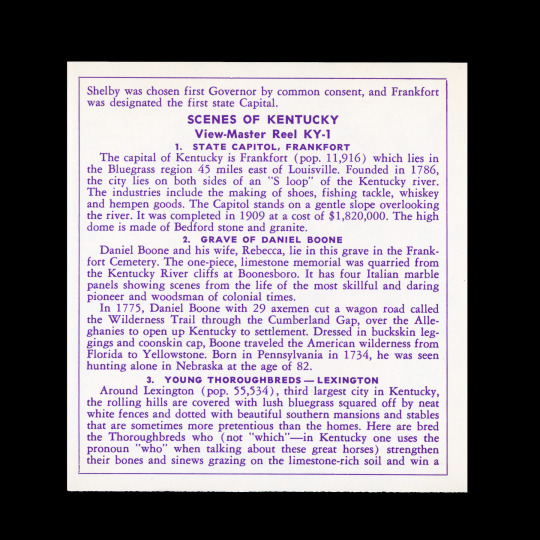
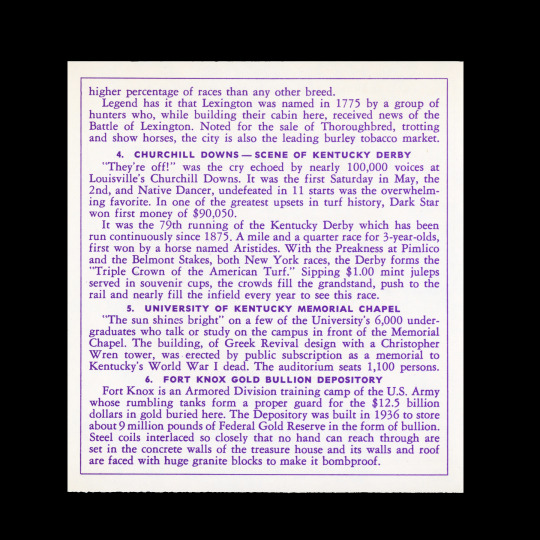
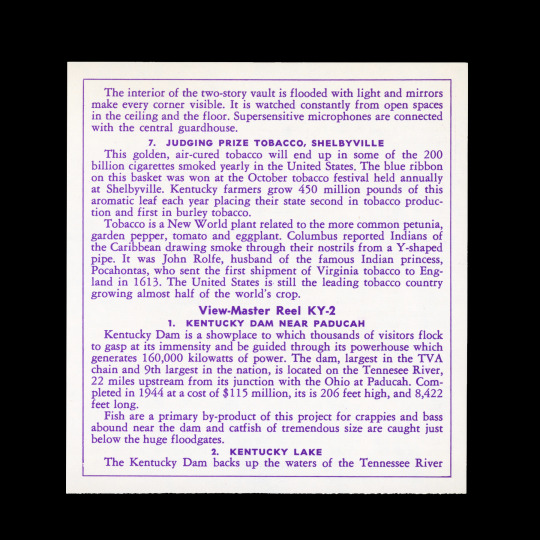


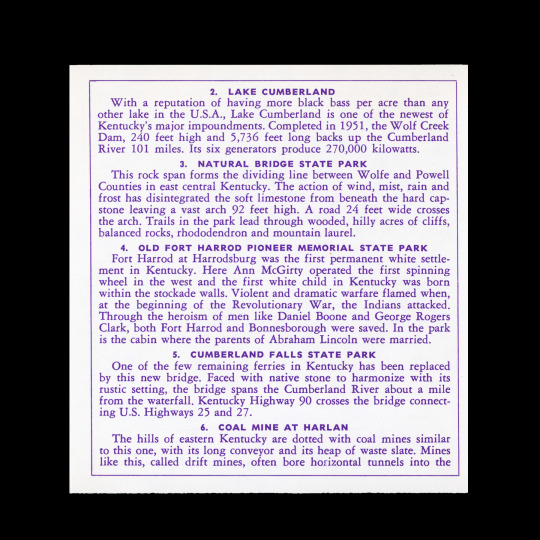

Brand: View-Master Packet Title: Kentucky Booklet Title: Kentucky Booklet Subtitle: The Bluegrass State Date: 1955
Note: When reading the booklet descriptions, please remember that these booklets are old (most are 65+ years old) and the information and history presented in them as factual may be inaccurate, outdated, and in some cases, offensive.
Booklet Introduction Description: Kentuckians are justifiably proud of their state. The modest ones will quote the words of a small-town Kentucky preacher who said, "Kentucky is a Heaven of a place." Others go so far as to say that Heaven is a "Kentucky of a place." It is the land of the Kentucky Colonel with his frosty mint julep, of Daniel Boone looking out at a wilderness paradise from the Cumberland Gap, of the Kentucky Derby and the fleet Thoroughbreds, of golden burley tobacco and Harlan County coal, of the birthplace of two presidents who went to war against each other -- Abraham Lincoln and Jefferson Davis, of Uranium 235 at Paducah, gold at Fort Knox, and bourbon whiskey at Lexington and Louisville.
KENTUCKY FACTS AND FIGURES Kentucky is called The Bluegrass State because the grass that covers the rolling plains of central Kentucky has tiny dusty blue blossoms. The State Flower is the Goldenrod; the Bird the Cardinal; the Tree is the Tulip Tree; the Motto is "United We Stand, Divided We Fall"; and the Song is Stephen Foster's "My Old Kentucky Home." The state whose farmers cleared the land to plant tobacco is the second largest tobacco growing state, and leads in burley tobacco. Tobacco is the leading crop bringing $175 million annually to farmers with corn second at $160 million. Most of the corn is turned into whiskey to the tune of $200 million per year. The leading mineral is coal, the state ranking third in the nation. Natural gas and gasoline are important products and about one-fourth of the nation's fluorspar is mined in Kentucky. Lexington is the world's largest loose-leaf tobacco market. The state is also famous for its hickory-smoked and sugar-cured hams. Half of all the big horseraces in the United States are won by Kentucky-bred horses. The Bluegrass State has raised such famous horses as Man O' War, Lexington, War Admiral, Equipoise, Sea Biscuit, Whirlaway, and Count Fleet.
THE STATE AND ITS PEOPLE Kentucky has an area of 40,395 square miles--36th in size among the states. It lies between the Alleghany Mountains and the Ohio River and is bounded by Indiana and Ohio on the north; West Virginia and Virginia on the east; Tennessee on the south; and Missouri and Illinois on the west. The Ohio River forms its entire north and northwest border and the Mississippi is part of its western border. The highest elevation in the state is Big Black Mountain (alt. 4,150) in Harlan County, the lowest (alt. 257) along the Mississippi. The state has a population of 2,944,806 (1950), ranking 19th among the states. Over 60% of the population is rural. Kentucky was a hunting ground and war ground for many tribes of Indians but home for none when the first settlers came. These white men were Scotch, English, Irish and German. Many of their descendants in the eastern hills still speak an Elizabethan English that sounds like passages from the King James Bible. Many famous people were born in Kentucky or called it home: Abraham Lincoln; Jefferson Davis; Daniel Boone; Irvin S. Cobb, the humorist of Paducah; Kit Carson, Indian scout and frontiersman born in Madison County; Henry Clay, the statesman whose home was in Lexington; D. W. Griffith, producer of the first great motion picture, Birth of a Nation, was born at La Grange; Carrie Nation, the hatchet-wielding temperance agitator was born in Kentucky, land of good bourbon whiskey; Zachary Taylor, our 12th president, grew up and is buried not far from Louisville; and even the storied Hatfields and McCoys really lived and feuded in the hills of Kentucky.
HIGHLIGHTS OF HISTORY The Kentucky country, for a long time, was the unexplored part of the Virginia colony. A lively curiosity sent land companies from Virginia and North Carolina into the new area. However, the first house was not built until Dr. Thomas Walker, in 1750, explored the Big Sandy River area establishing a base near Barbourville. Daniel Boone, with a group of hunters, entered the Kentucky Valley in 1767 where he met the famous Long Hunters. These were adventurous white men whose extended hunting trips took them over the mountains from North Carolina. The first permanent settlement was established by James Harrod and a company of adventurers from Pennsylvania at Harrodsburg in 1774. In 1776, Kentucky was organized as a Virginia county. In 1780, George Rogers Clark, whose younger brother was the co-leader of the Lewis & Clark Expedition, led 3,000 settlers down the Ohio from Maysville to Louisville. In "broadhorn" boats that looked like an adaptation of Noah's Ark, the settlers ran a gauntlet as Indians lay in ambush on the Kentucky shore and showered the boats with a rain of deadly arrows. Kentucky became the 15th star in the American Flag in 1792. Isaac Shelby was chosen first Governor by common consent, and Frankfort was designated the first state Capital.
1 note
·
View note
Link

France's subantarctic Île aux Cochons was once home to half a million breeding pairs of king penguins. Now, only 60,000 remain. Liam Quinn / Flickr / CC BY-SA 2.0
Excerpt:
The world's largest colony of king penguins declined nearly 90 percent in the last three decades, researchers announced Monday.
The colony inhabits France's subantarctic Île aux Cochons or Pig Island. Observations from the 1980s showed that it was once home to 2 million king penguins, making it the planet's largest colony of the species, and also the second largest colony of all penguins.
However, new satellite images and aerial photographs taken from a helicopter show that the colony's breeding grounds have been overrun by vegetation, according to a paper published in the journal Antarctic Science.
The researchers estimates that the total king penguin population has shrunk by 88 percent over the past 35 years, with barely 200,000 animals left on the island.
There is no definitive explanation for the massive decline.
"It is completely unexpected, and particularly significant since this colony represented nearly one third of the king penguins in the world," lead author Henri Weimerskirch, an ecologist at the Centre for Biological Studies in Chize, France, who has observed the colony since 1982, told AFP.
However, the team suggested that their numbers may "fluctuate extensively" after large-scale climatic events. A particularly strong El Nino weather event in 1997 warmed the southern Indian Ocean, which drove fish and squid—penguins' main food—beyond a distance that penguins could travel to hunt.
"This resulted in population decline and poor breeding success" for all the king penguin colonies in the region, Weimerskirch said.
A previous study in February also suggested that climate change could force out 70 percent of the world's king penguin population by 2100. As the Antarctic ocean warms, the penguins' primary hunting grounds will be pushed further poleward and away from their original breeding grounds, the researchers said.
3 notes
·
View notes